Hardware
PowerColor Red Devil Radeon RX 570 Video Card Review
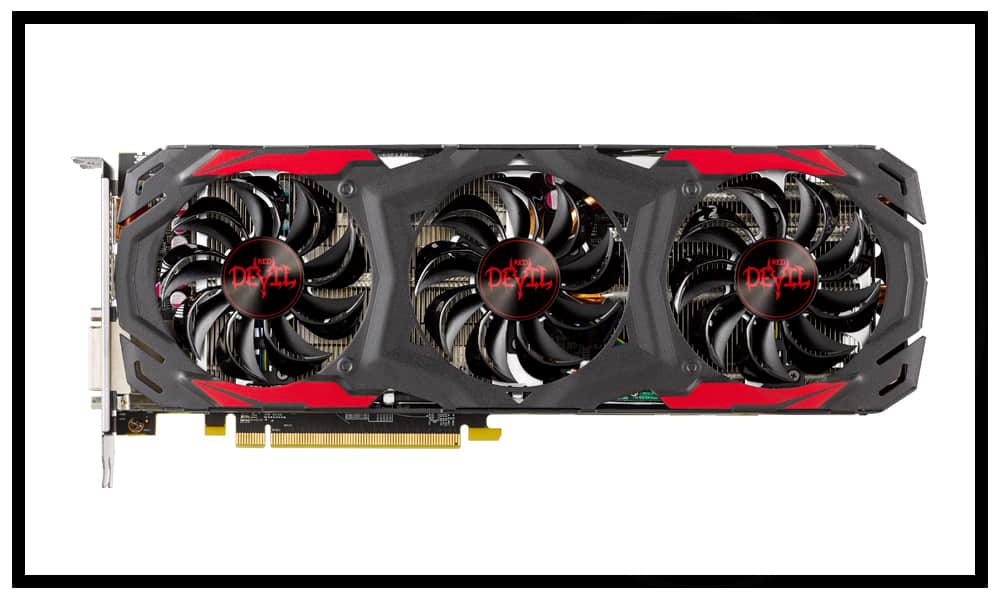
Introduction
Over the last few months, there’s been a massive influx of graphics cards on the market. However, most of the newest cards are on the higher end of the pricing spectrum. But what if you’re on a tighter budget or you just don’t require the power of a high-end card? Don’t worry, because AMD has got you covered with the release of their 500 series of GPUs, a refresh of their very popular Polaris-based 400 series of cards.
PowerColor Red Devil RX 570 utilizes 4GB of GDDR5 memory with 2048 stream processors, ships with a 1320MHz core clock speed, and has a 1750MHz memory clock speed which is connected via a 256-bit memory interface. The 6+1 multi-phases board design enhances the power efficiency and stability. In order to achieve better thermal performance, the PowerColor Red Devil RX 570 adopts the newest fan technology called Double Blade III which increases airflows and prevents dust deposition on fans. The Double Blade III is made with triple 80mm 2-ball bearing fans.
When it comes to AMD graphics cards, there are several companies out there that do a good job at custom PCBs and coolers. There are few cards as popular as the PowerColor Red Devil lineup. With the release of the 500 series, no doubt, there would be a new Red Devil card or two. In fact, we happened to get our hands on the new Red Devil RX 570. However, with the 500 series being a refresh, can the Red Devil RX 570 be all that different than the RX 470 from the last generation? We put the new Red Devil RX 570 through our suite of benchmarks. So, let’s see how it did.
PowerColor’s Take on the Red Devil Radeon RX 570
AMD Eyefinity Technology
Run multiple displays from a single graphics board and expand your gaming field of view across all displays.
GCN Architecture
A new design for AMD’s unified graphics processing and compute cores that allows them to achieve higher utilization for improved performance and efficiency.
AMD App Acceleration
AMD App Accelerator creates a co-processing environment in which the compute processing potential in your AMD Radeon Graphics processor works together with the system central processor, to accelerate enabled applications.
AMD HD3D Technology
Supports the latest stereoscopic 3D content and display technologies
Play 3D games, watch Blu-ray 3D videos, and edit 3D photos on your 3D Monitors, TV, or projector.
AMD CrossFire™ Technology
Multi-GPU support offers superior scalability
Increase our gaming performance up to 2x with AMD CrossFire technology, 2.75x for TriFire configurations, or 3.75x with QuadFire configurations.
AMD HD Media Accelerator
Assumes rendering responsibility for HD encode (VCE)/decode (MPEG-4 ASP, H.264. MVC, MPEG2, etc.) and conclusively enable superior video playback quality with advanced hardware post-processing algorithms.
AMD PowerPlay Technology
AMD PowerPlay Technology dynamically adjusts clock speeds in response to GPU load, saving power for just when you need it.
AMD PowerTune Technology
Maximizes performance under load conditions by dynamically increasing the GPU engine clock to take advantage of unused TDP headroom. Also allows users to configure their own TDP limit, within a provided range, for even higher performance or more power efficiency.
PCI Express 3.0
Delivers double the bandwidth per lane of PCIe Gen 2 for faster GPU.
Microsoft Windows 7 Support
Comprehensive OS supports the latest Windows 7 functionality and Driver support.
Microsoft Windows 10 Support
Comprehensive OS supports the latest Windows 10 functionality and Driver support.
Advanced GDDR5 Memory Technology
GDDR5 memory provides the highest available memory bandwidth of any memory technology today, enabling higher GPU performance.
Gold Power Kit
The Solidly-built Components enhance the stability, performance, efficiency and quality.
HDMI
Integrated high speed HDMI output with 1080p 120Hz 3D Stereoscopic support, and 4K resolution display support.
Microsoft DirectX 12
Get intense gaming performance and unrivalled image quality with stunning 3D visual effects, realistic lighting and lifelike imagery.
Mute Fan Technology
Providing noiseless environment and reducing the power consumption when the GPU temperature is low than 60°C.
UEFI Support
Better security by helping protect the pre-startup, or pre-boot process against boot kit attacks and faster startup times and resuming from hibernation.
Virtual Super Resolution
Get quality that rivals 4K, even on a 1080p display while playing your favorite online games thanks to AMD’s VSR.
Radeon VR Ready Premium
Delivering immense visual power and unmatched technological innovation, AMD’s VR Ready Premium solutions set the bar for enabling premium experiences on high-end VR games, entertainment, and applications.
AMD XConnect Ready
With AMD XConnect technology, external GPU enclosures configured with Radeon Graphics can easily connect and disconnect to a compatible ultrathin notebook or 2-in-1 over Thunderbolt 3 at any time, just like a USB flash drive-a first for external GPUs.
Radeon Chill
Radeon Chill can improve power efficiency and can lower temperatures for supported products and games when enabled through Radeon Settings.
Radeon ReLive
Capture, stream and share your greatest moments and gaming wins with Radeon ReLive. Modify settings quickly, conveniently, and play seamlessly with the easily accessible in-game toolbar. Express yourself in bold new ways with custom scene layouts.
Features and Specifications
Graphics Engine
- Radeon RX 570
Video Memory
- 4GB GDDR5
Core Clock
- up to 1320MHz with boost
Memory Clock
- 1750MHz x4 (7.0Gbps)
Memory Interface
- 256bit
DirectX® Support
- 12
Bus Standard
- PCIE 3.0
Standard Display Connectors
- DL DVI-D/ HDMI/ DisplayPort x3
Feature Support
OpenGL Support
- Yes
CrossFireX™ Technology
- Yes
AMD Stream Technology
- Yes
AMD Eyefinity Technology
- Yes
Display Support
DVI Output
- 1 x DVI-D
DisplayPort
- DisplayPort x 3
HDMI
- 1
HDCP Support
- Yes
Maximum Resolution
- DVI
- 2560×1600
- DisplayPort
- 4096×2160
- HDMI
- 4096×2160
Power Specs + Board Dimensions
Board Dimensions
- 310mm x 128mm x 38mm
Minimum System Power requirement (W)
- 450W
Extension Power Connector
- One 8-Pin PCI Express Power Connector
Packaging and Unboxing
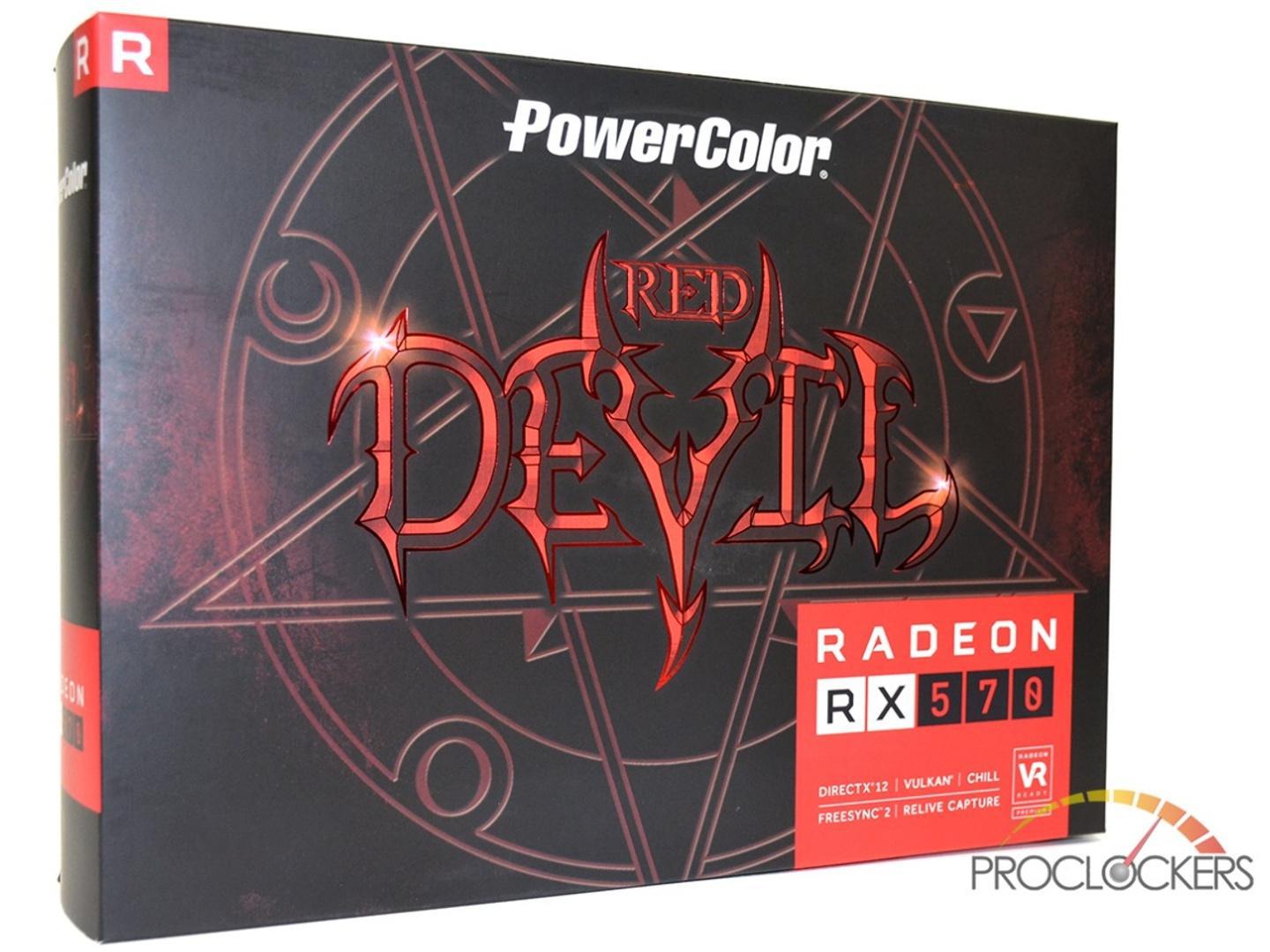
The PowerColor Red Devil RX 570 comes packed in a matte-black box, with the PowerColor Logo centered on the top. Directly below, we find the beautiful, and intricate, Red Devil logo. This takes up most the front of the package. In the bottom right corner, we see the Radeon logo and the RX 570 branding. Below that is a list of a few of the main features of the graphics card. These include DX12 support, Vulcan support, Chill support, as well as FreeSync technology and Relive capture.
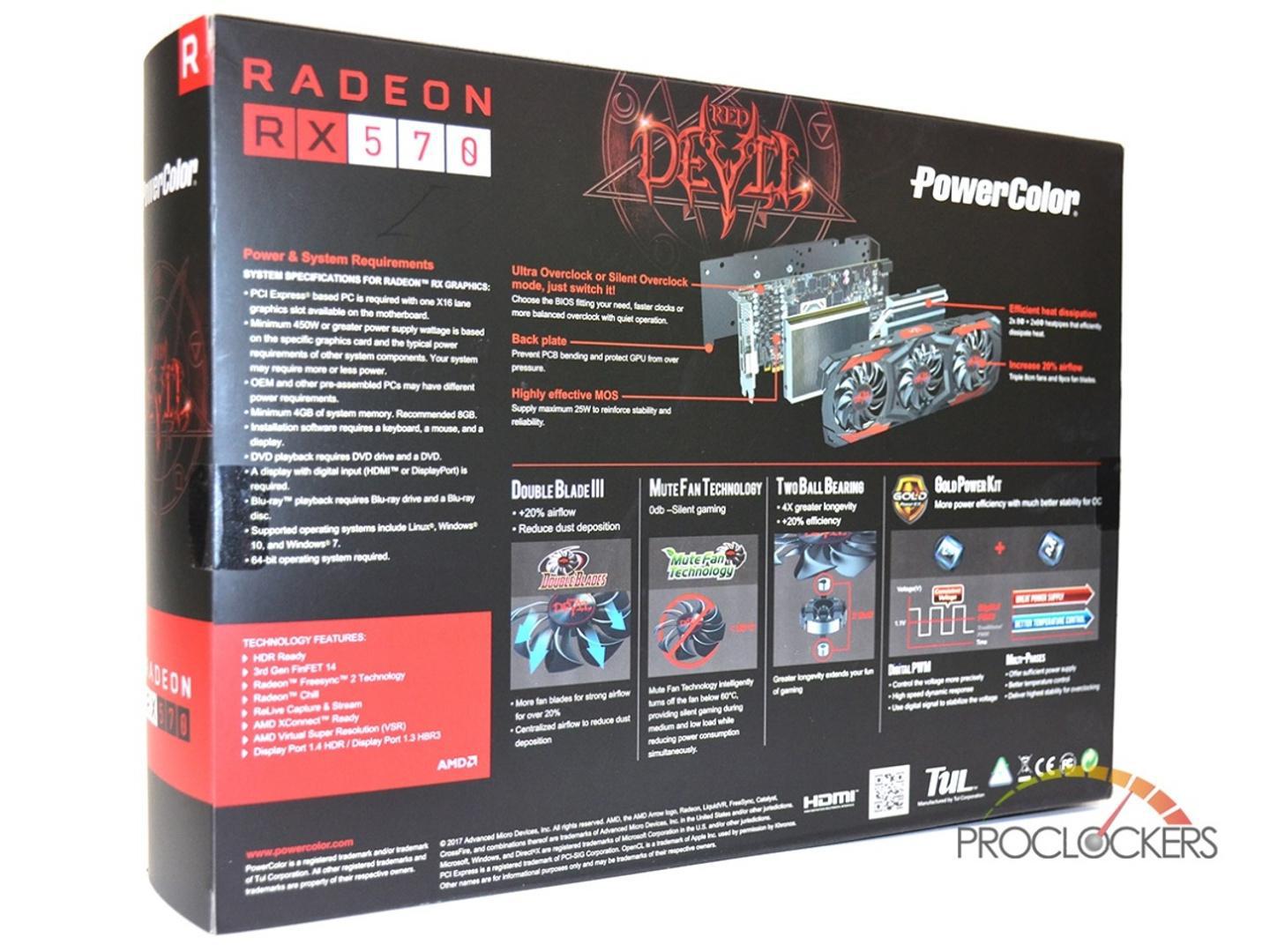
The rear of the package displays a lot of information. Across the top, from left to right, we first see the Radeon logo and RX 570 product branding. In the center, The Red Devil logo, followed by the PowerColor logo. Just below the Radeon logo, are a list of system specifications and power requirements for the Red Devil RX 570. Just to the right of the specifications and requirements, there is a blown-out depiction of the Red Devil RX 570, with descriptions of the main components of the card.
In the bottom right corner, there is a list of some of the Radeon technology features of the Red Devil RX 570. Some of these features include Radeon FreeSync technology, Radeon chill, and AMD virtual super resolution. Below the blown-out picture of the card, there are there are depictions of the main features of the cooler. These include the Double Blade III fans, Mute Fan Technology, Two Ball Bearing Fans and the Red Devil’s Gold Power Kit.

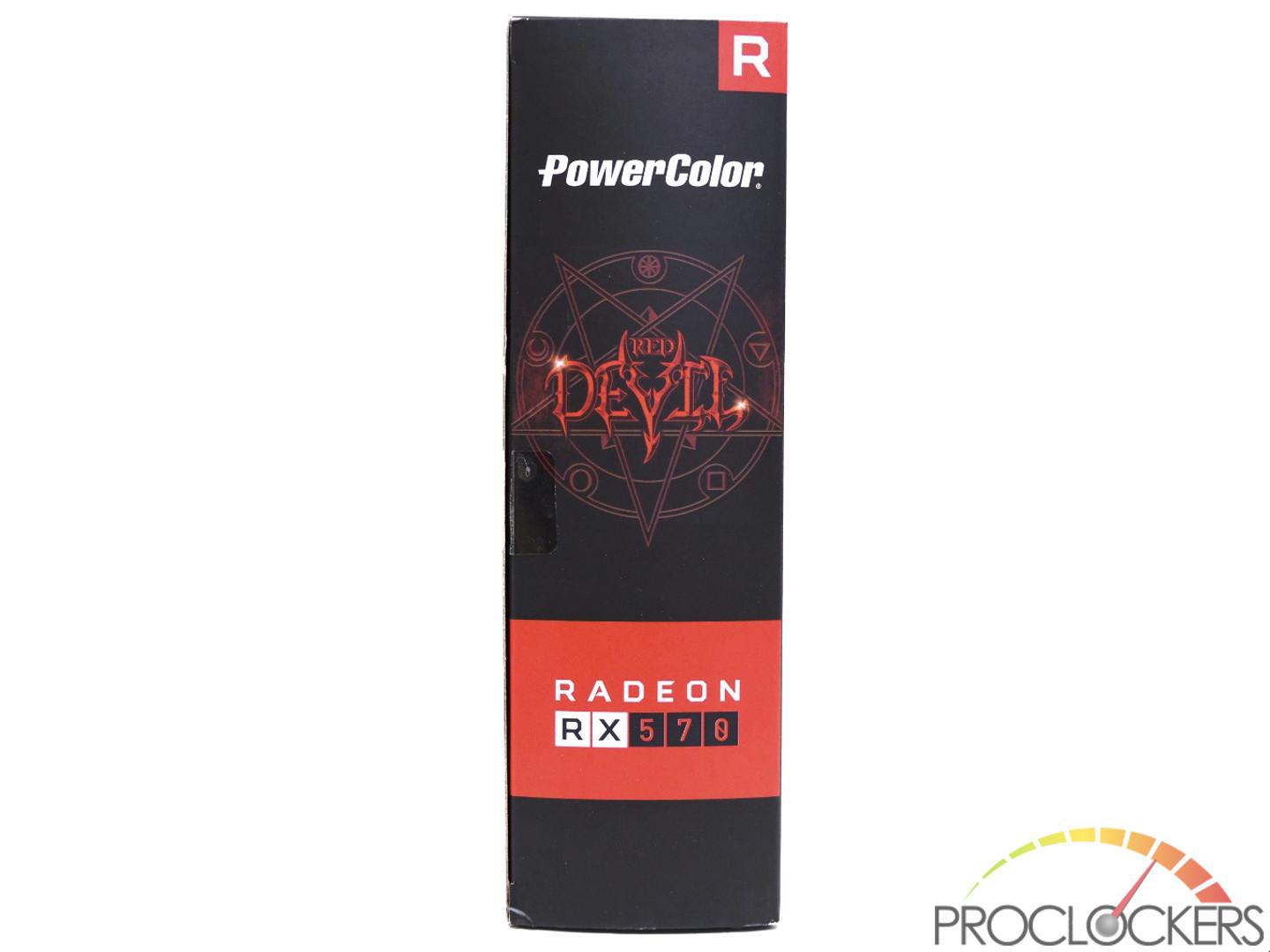
Both the left and the right side of the box are the same. The top has the PowerColor logo. Just below that is the Red Devil logo. Along the bottom is the Radeon logo with the RX 570 product branding.
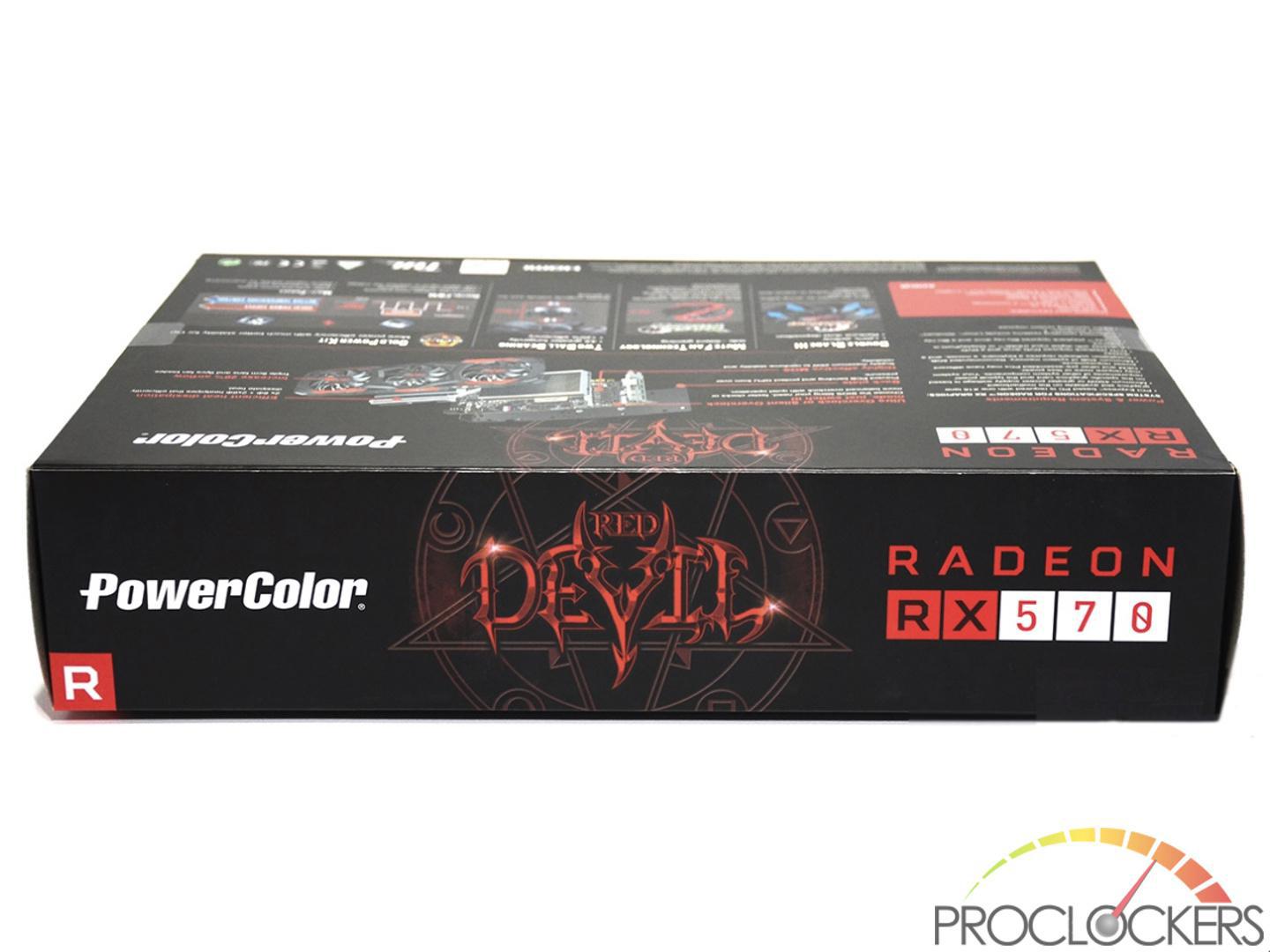
The top of the box has the PowerColor logo to the left and the Red Devil logo in the center. To the right is the Radeon logo and RX 570 product branding.
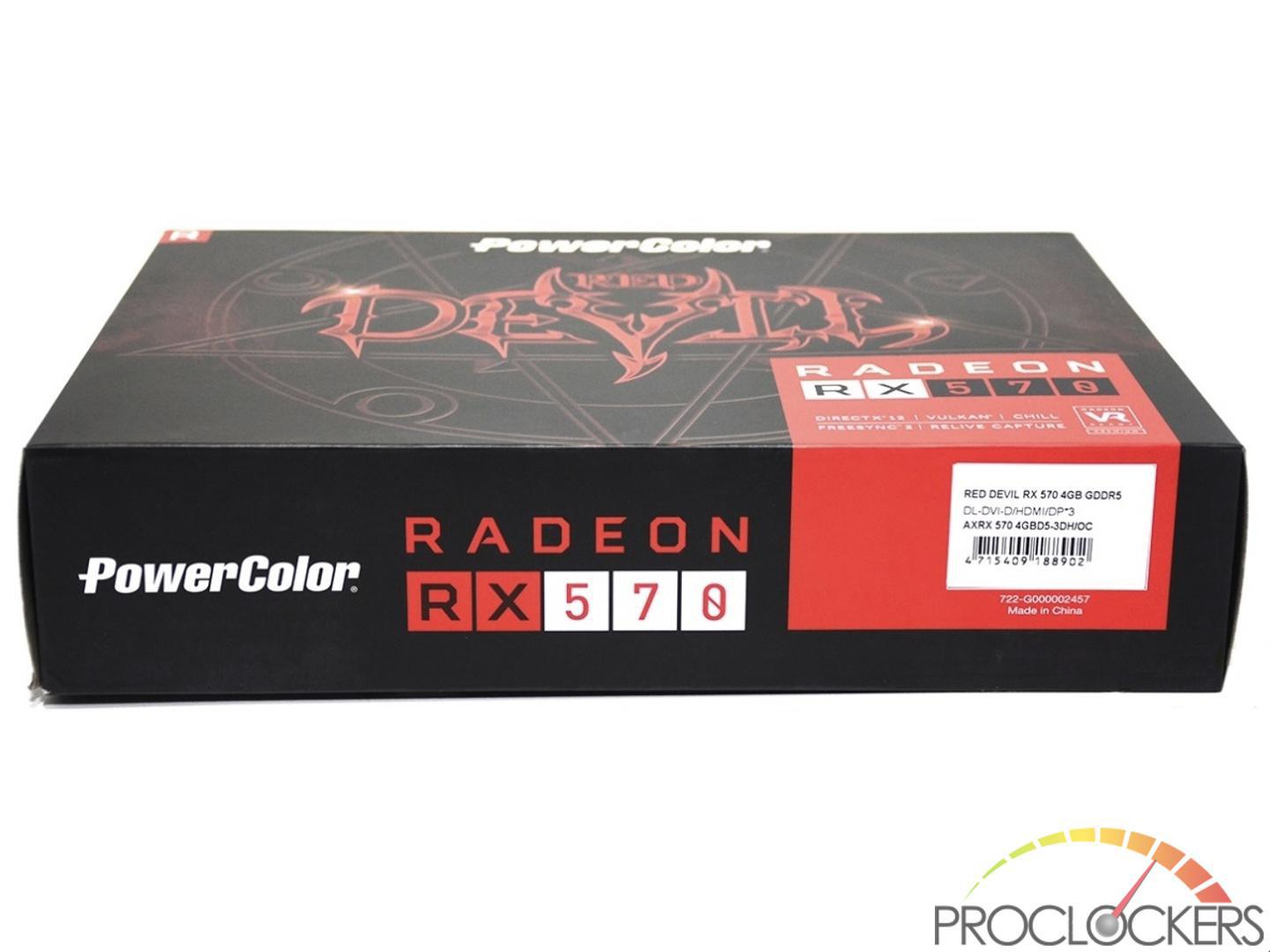
The bottom of the box has the PowerColor logo to the left, and the Radeon logo and RX 570 product branding in the center. To the far right, we find the UPC code, model and serial numbers.
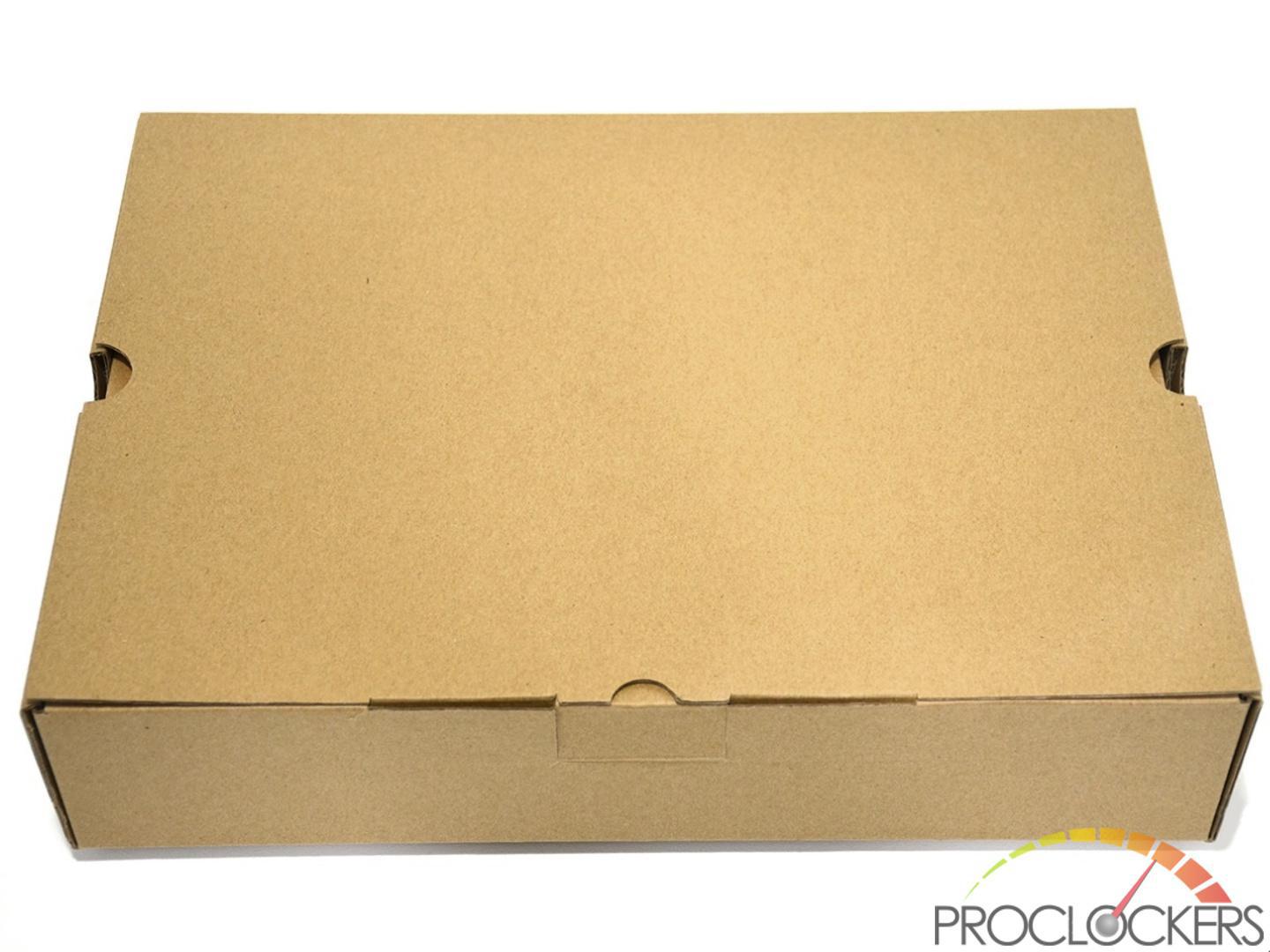
The internal packaging is a plain brown box that offers plenty of protection when being shipped or stored. The card comes in an anti-static bag, and has driver disk and user manual packed with the card.
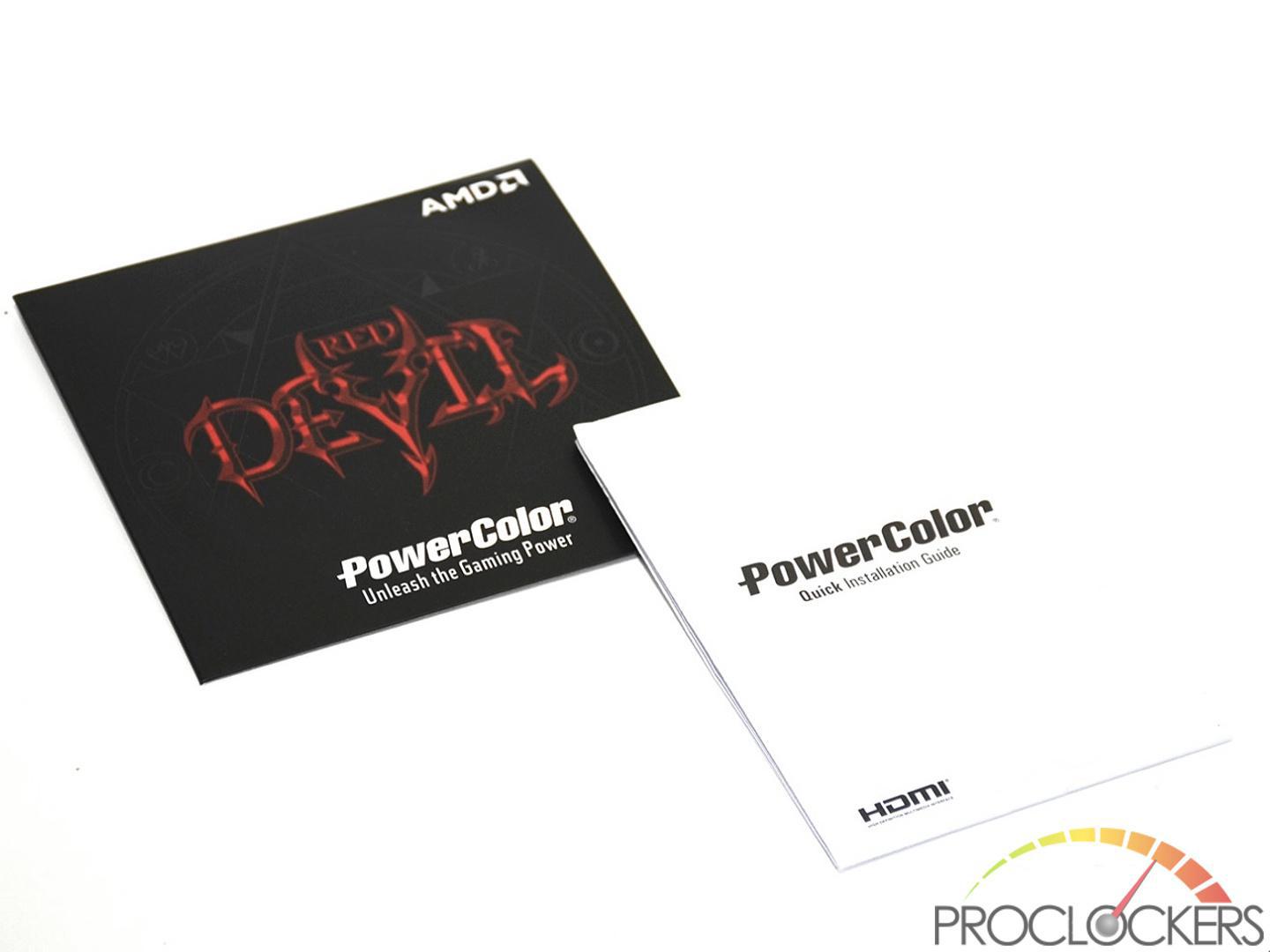
The accessories are limited to a driver disk and a quick start user guide.
A Closer Look
The Red Devil RX 570 is a refresh of the Red Devil RX 470. The GPU runs at up to 1320MHz with boost. The Red Devil RX 570 has 4 GB of GDDR5 memory running at 1750MHz on a 256-bit memory bus. Measuring in at 310mm x 128mm x 38mm, it’s longer than its last generation counterpart, the Red Devil RX 470. In fact, the biggest update to the Red Devil RX 570 is the addition of the third fan. The Red Devil RX 470 was only a dual fan card.
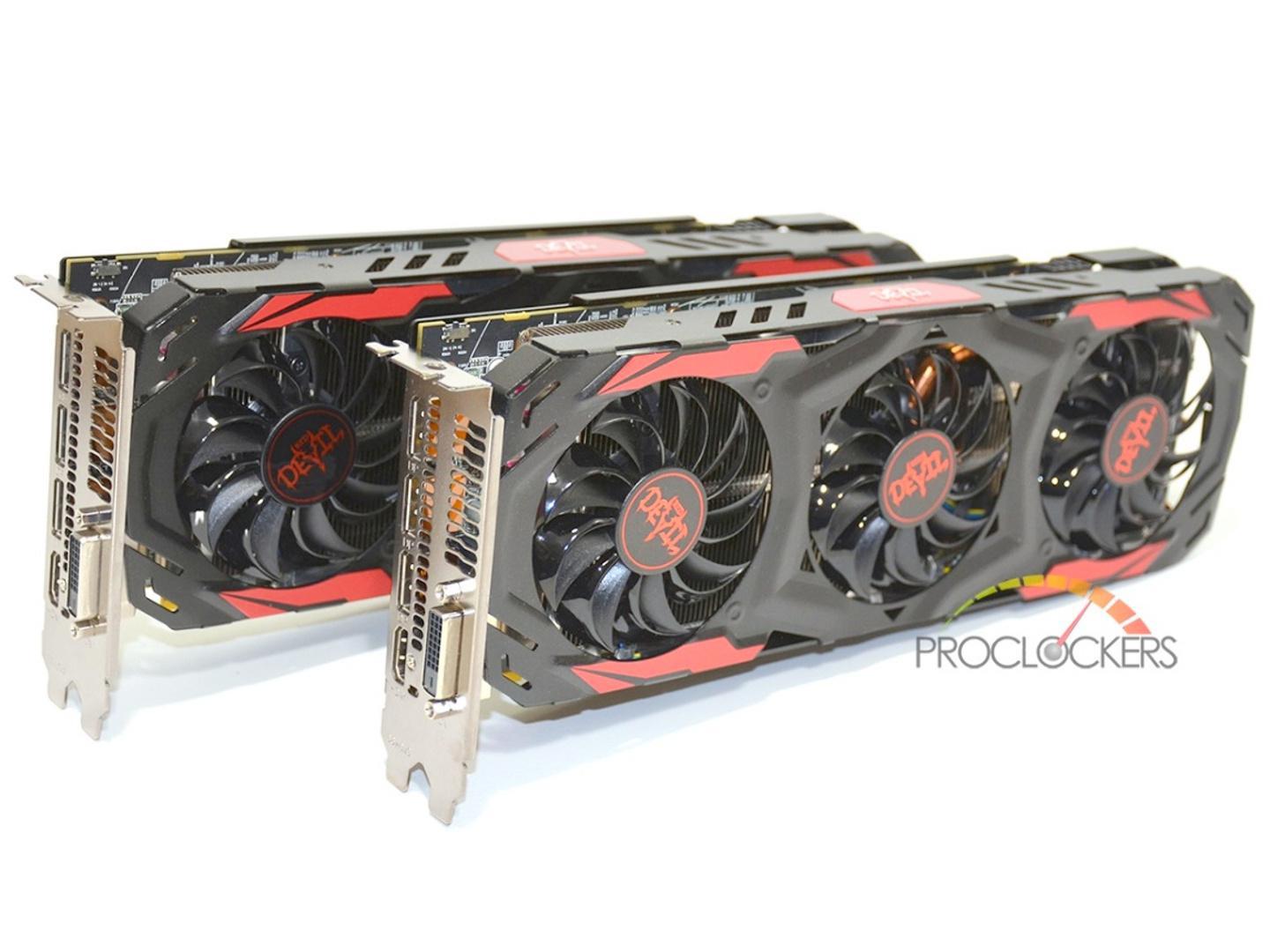
With the addition of the third fan, the Red Devil RX 570 looks identical to the Red Devil RX 480 of the previous generation. This is true right down to the backplate on the Red Devil RX 570.
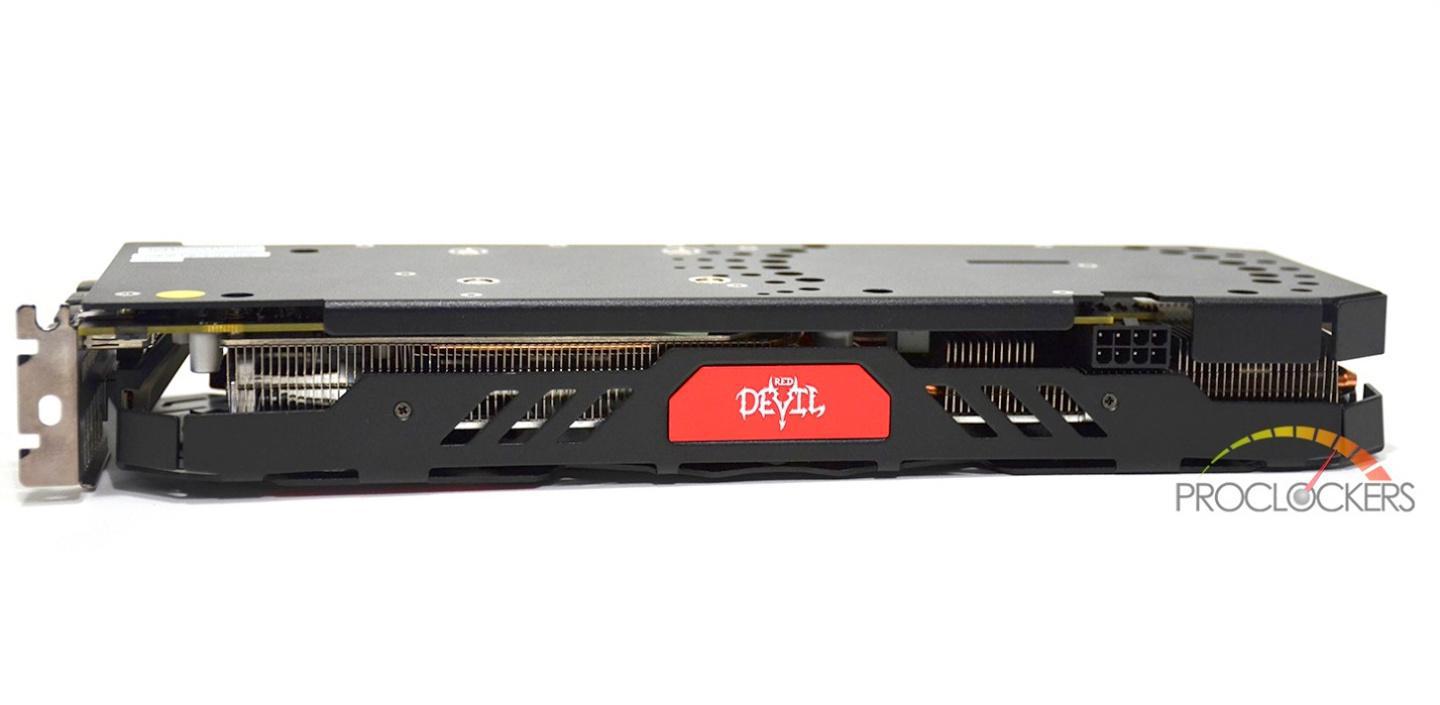

The Red Devil RX 570 has PowerColor’s patented Double Blade III fans, first introduced last generation. The split-blade design of the Double Blade III fans increases the airflow by over 20%. This design centralizes airflow and down on dust build up at the same time. Each fan is equipped with two sets of ball bearings. This not only increases the lifespan of each fan up to four fold, but it also increases the efficiency of each fan by up to 20%.
The Red Devil RX 570 is equipped with Mute Fan Technology. This allows the fans to remain idle when the card is below 60°C and helps keep the noise levels down when you’re simply watching YouTube, a movie, or working.
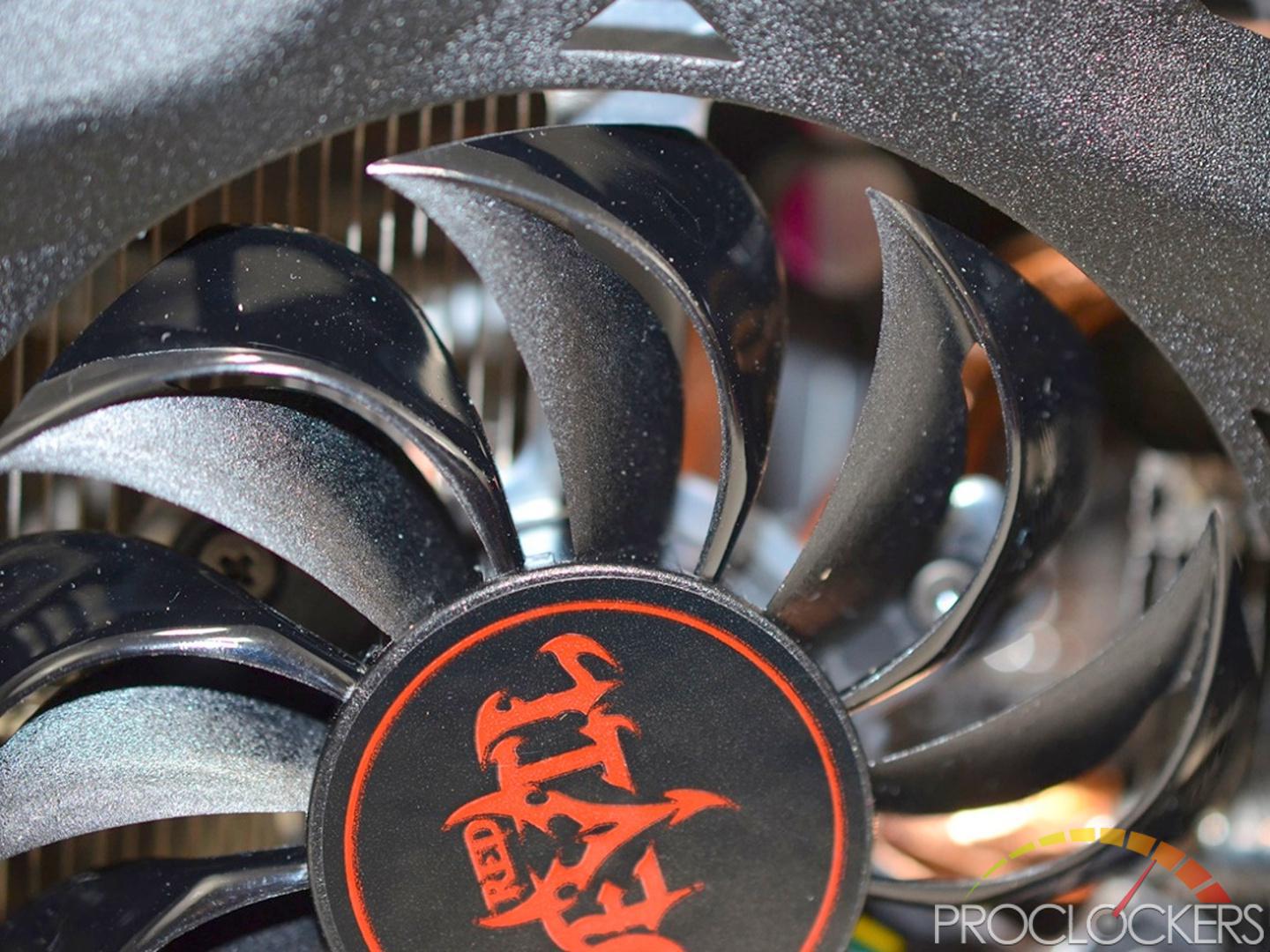
Here you can see the unique design of the Double Blade III Fans.
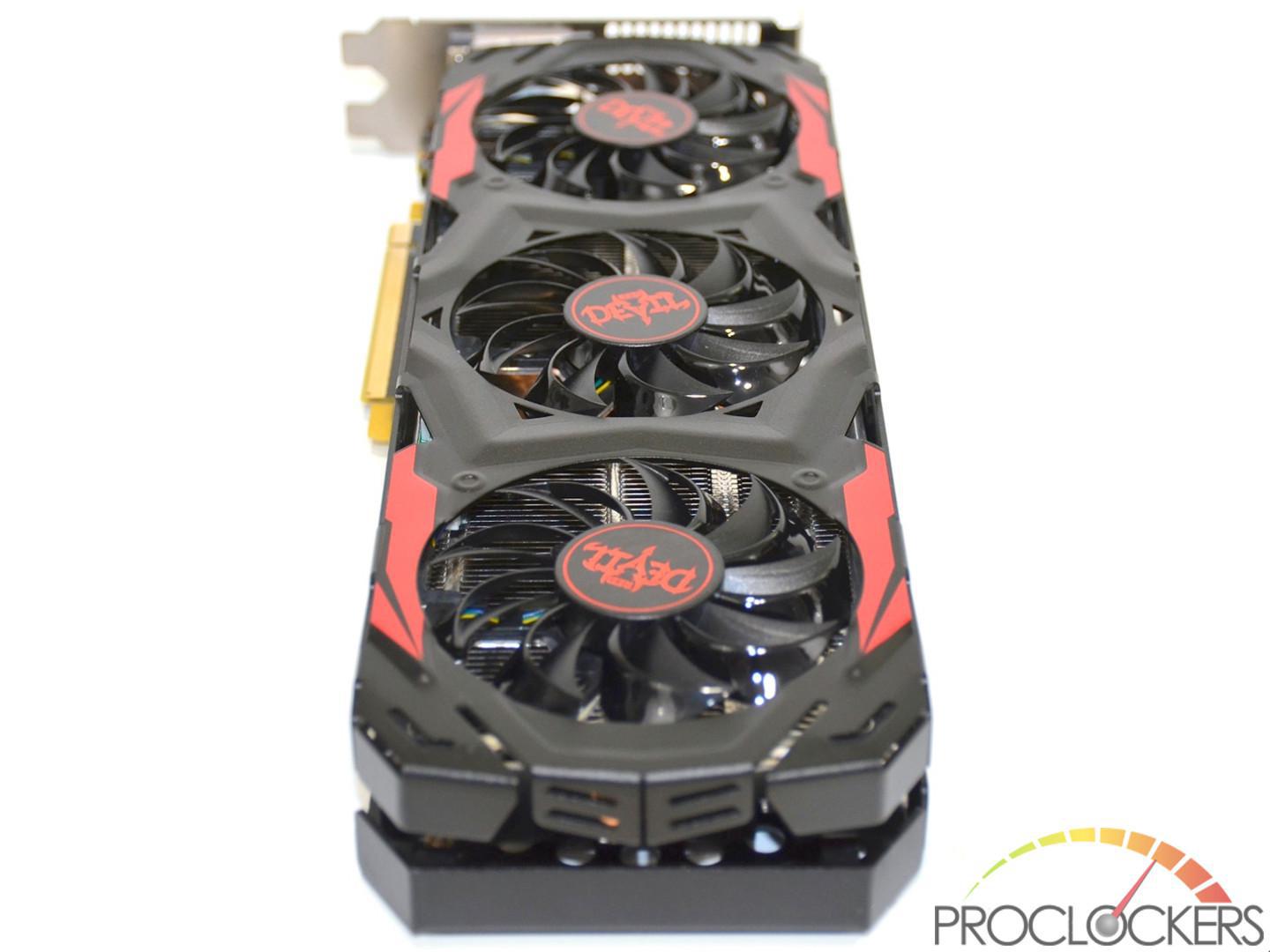
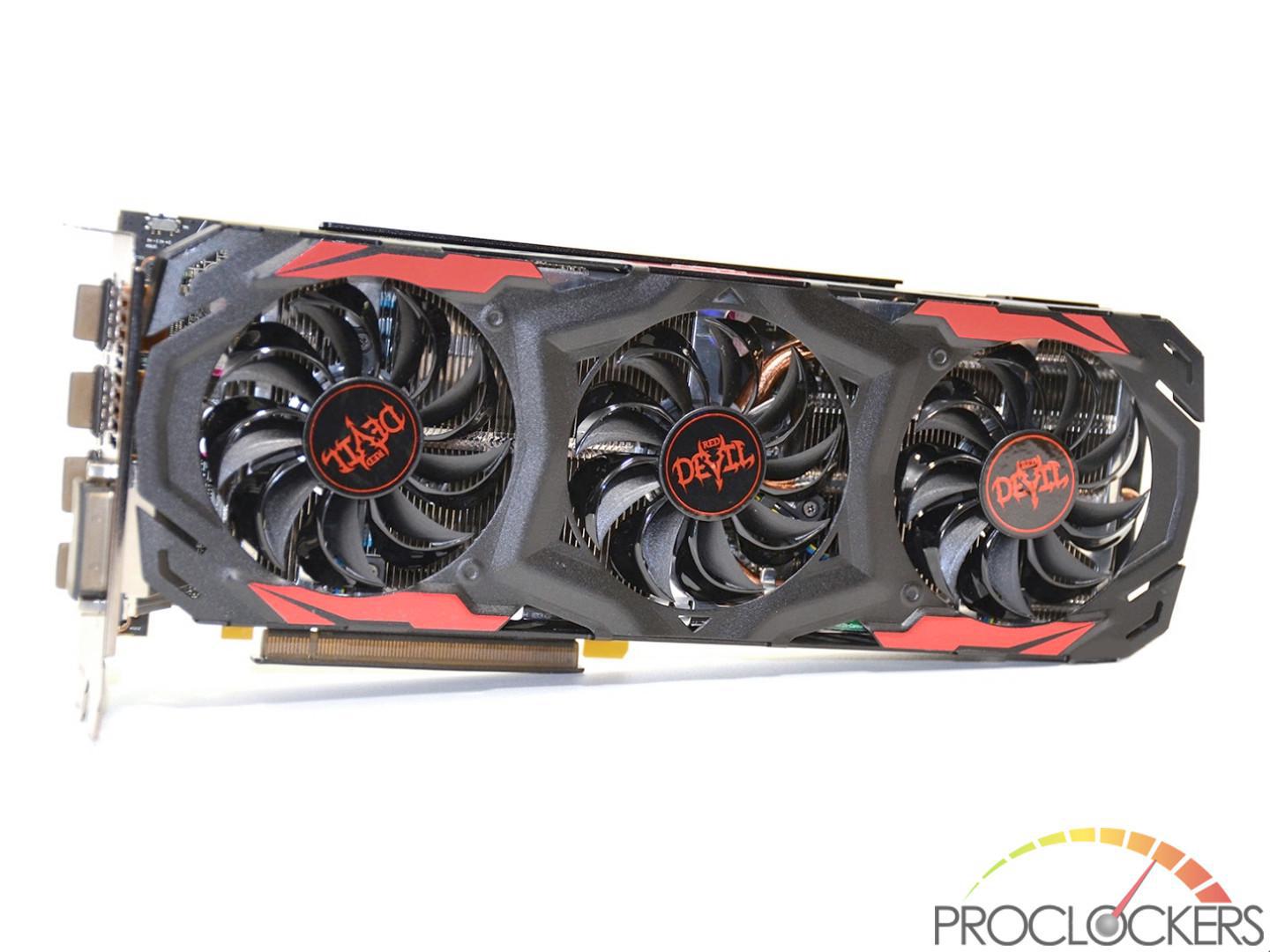
The Red Devil RX 570 has been upgraded to a 3 fans card. The Red Devil RX 470 was only a dual fan card.
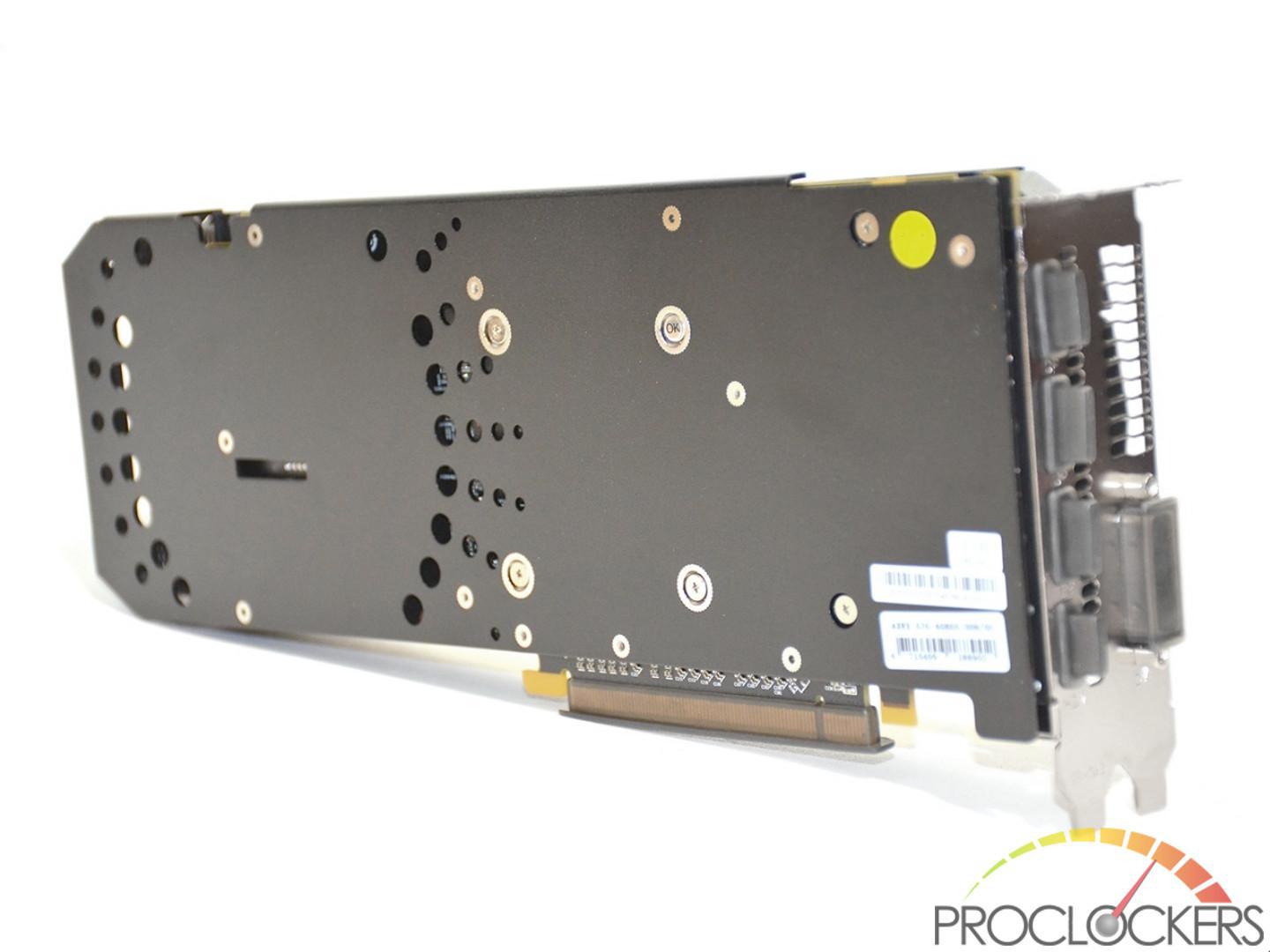
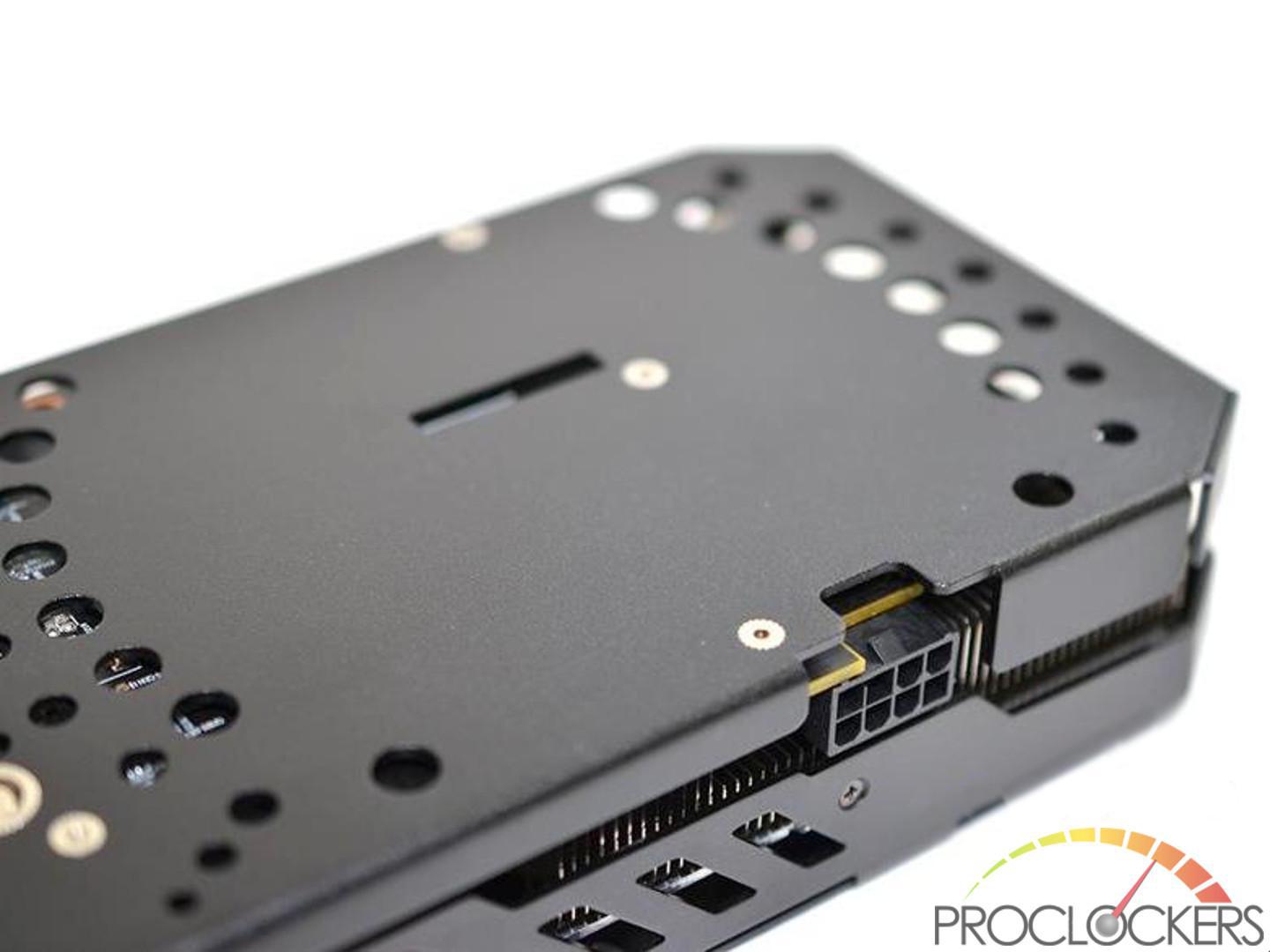
The Red Devil RX 570 has a backplate with a unique design. The holes on the back plate also double as ventilation to help dissipate heat.
The Red Devil RX 570 has a single 8-pin connector and a minimum of 450-watt power supply is recommended.
The side of the card has a Red Devil badge in the center of the card.
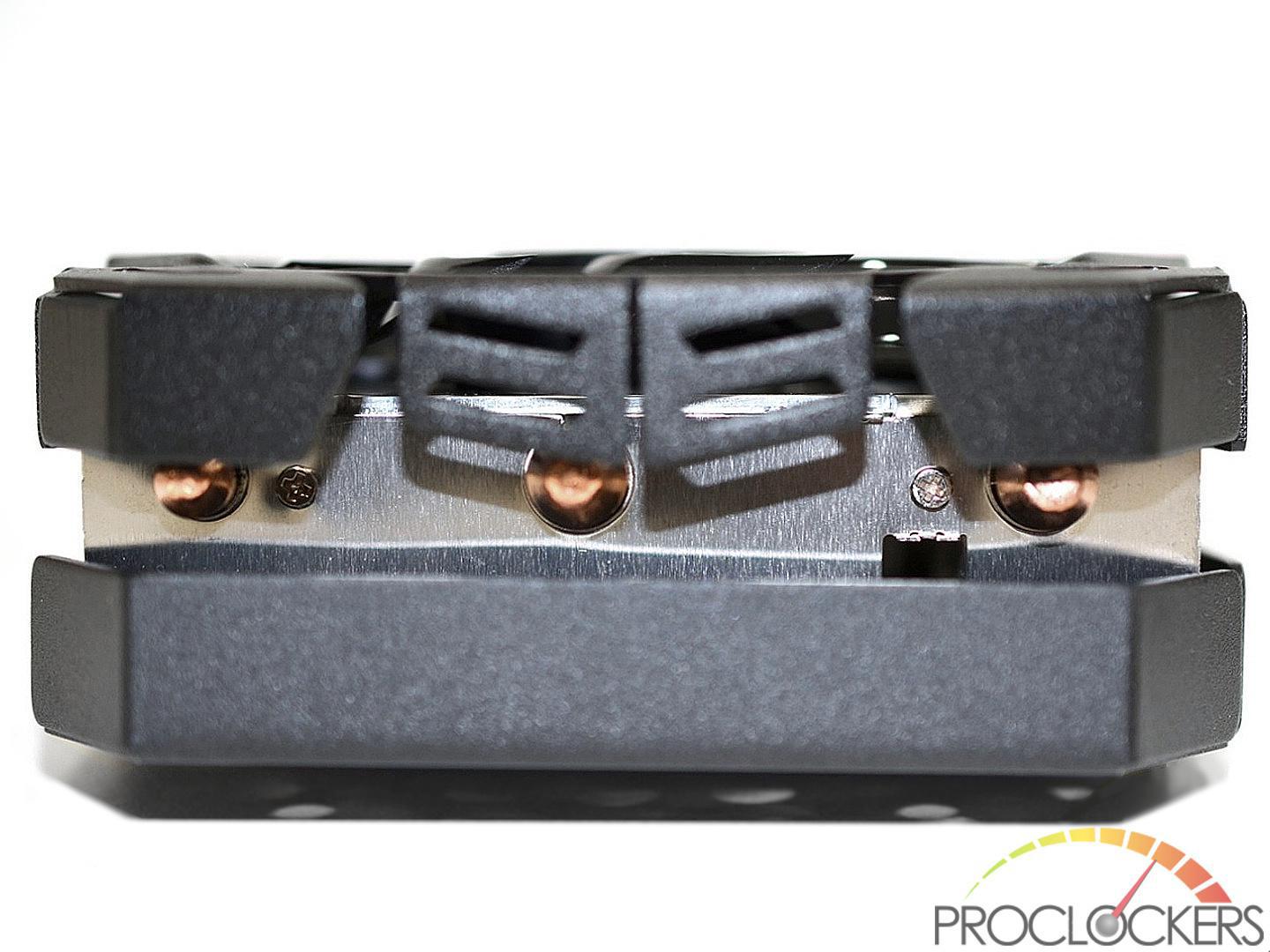
This rear view of the card shows how thick the card is. You can also see the three massive heat pipes that make up part of the Red Devil cooler.
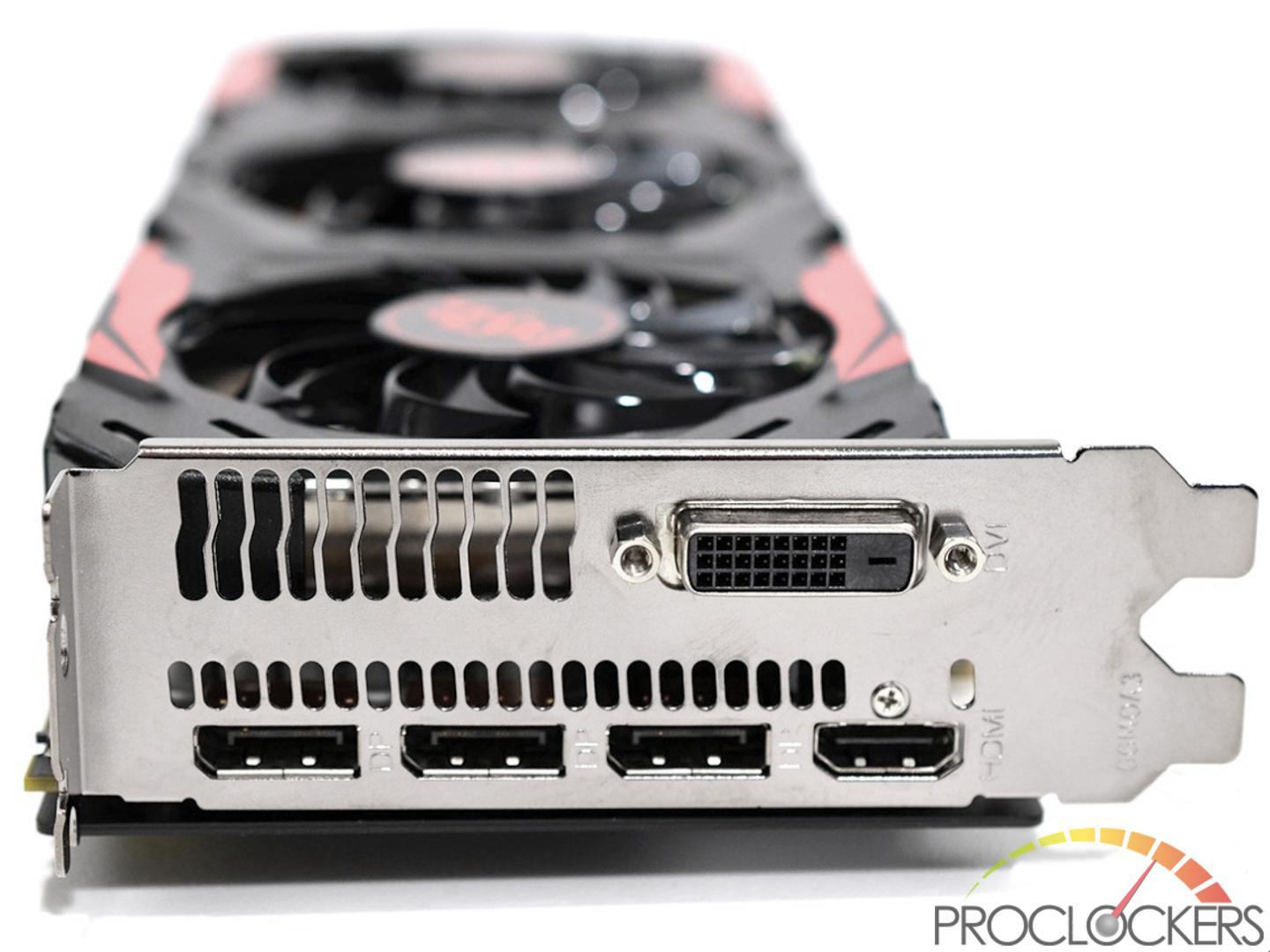
The ports on the Red Devil RX 570 consist of a single DVI-D, a single HDMI and three DisplayPort ports.
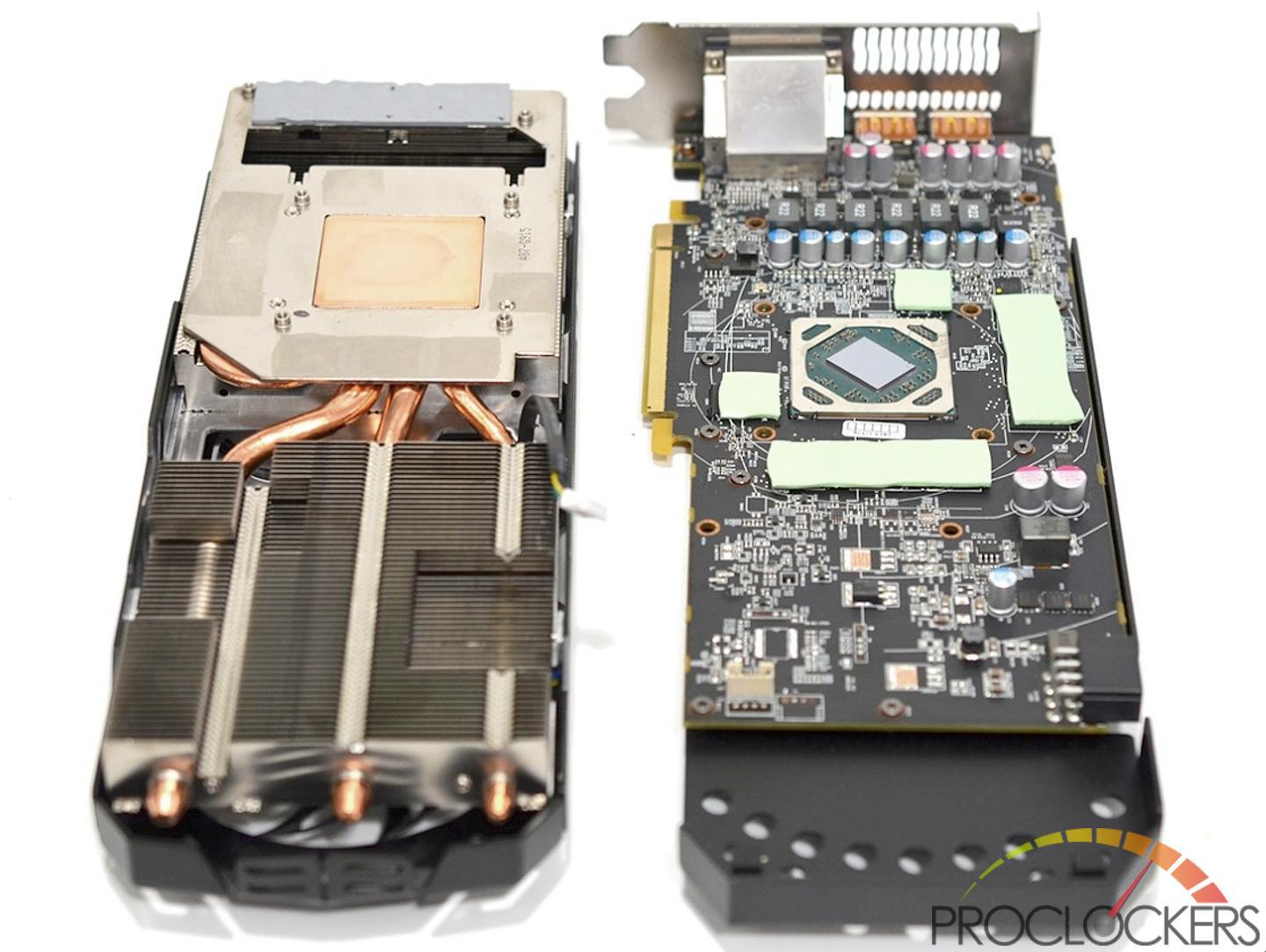
We removed the cooler from the PCB to show you what the Red Devil RX 570 looks like at its core. The first thing I noticed was how both the backplate in the cooler were longer than the PCB. The last fan even overlaps the heatsink.


The cooler is made up of three copper heat pipes set in an array of dense, aluminum fins. Underneath the 3 Double Blade III fans, we find a copper base plate connected to a series of three, rather thick copper heat pipes. These heat pipes work their way through an array of dense aluminum fins that make up the rest of the Red Devil cooler.

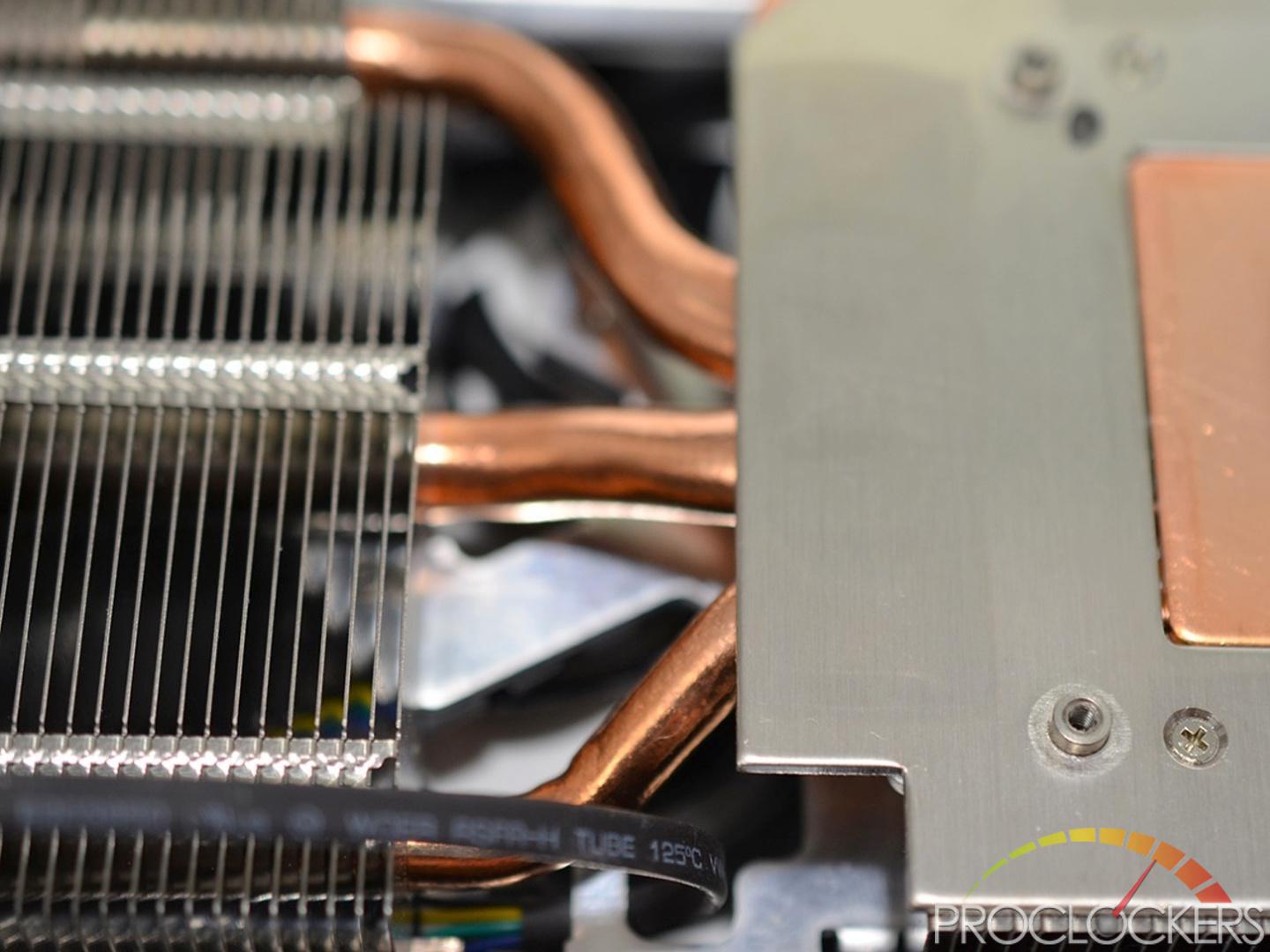
The Red Devil RX 570 has a copper base plate that attaches to the heat pipes.
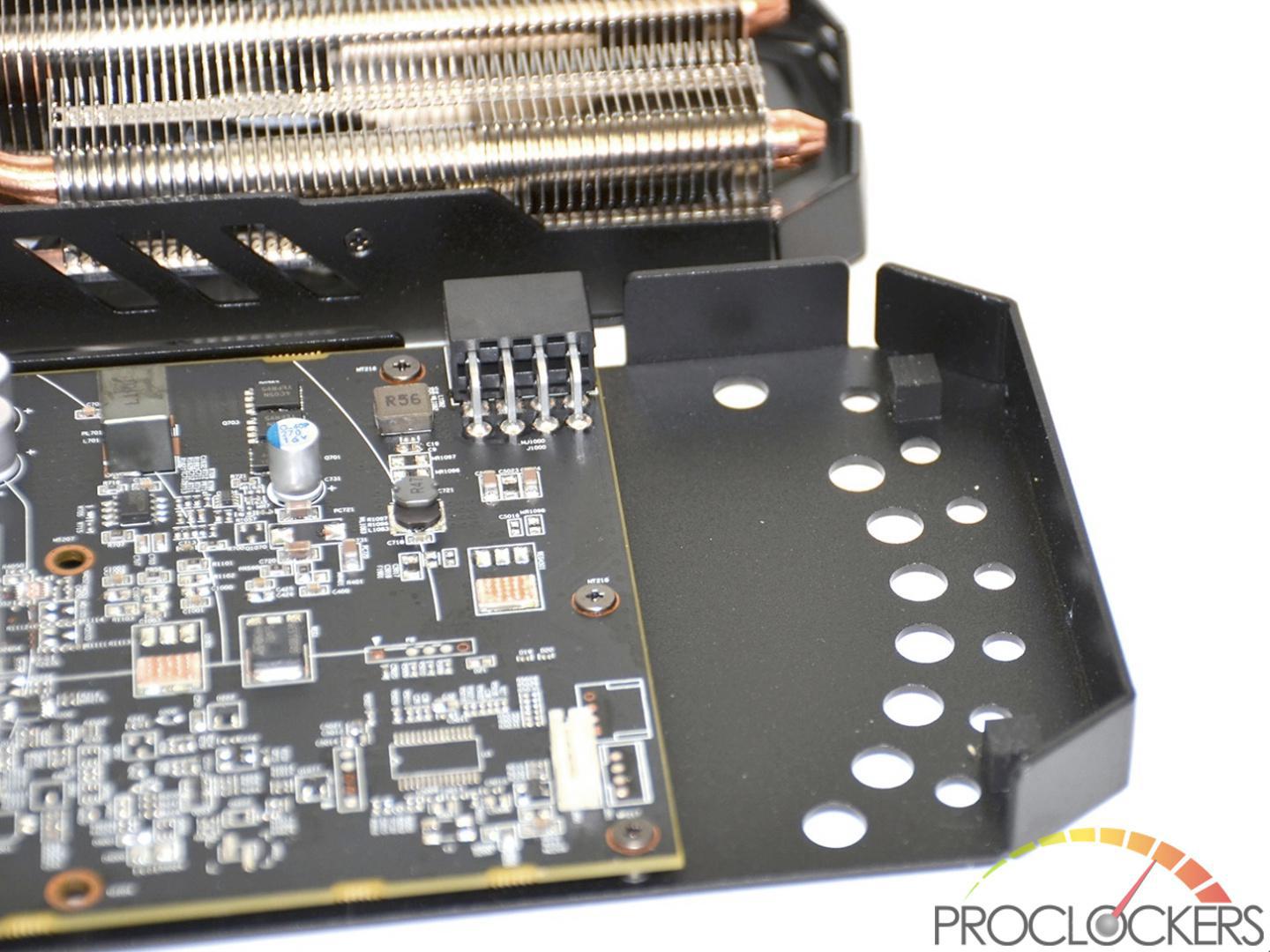
The back plate overlaps the PCB of the card.
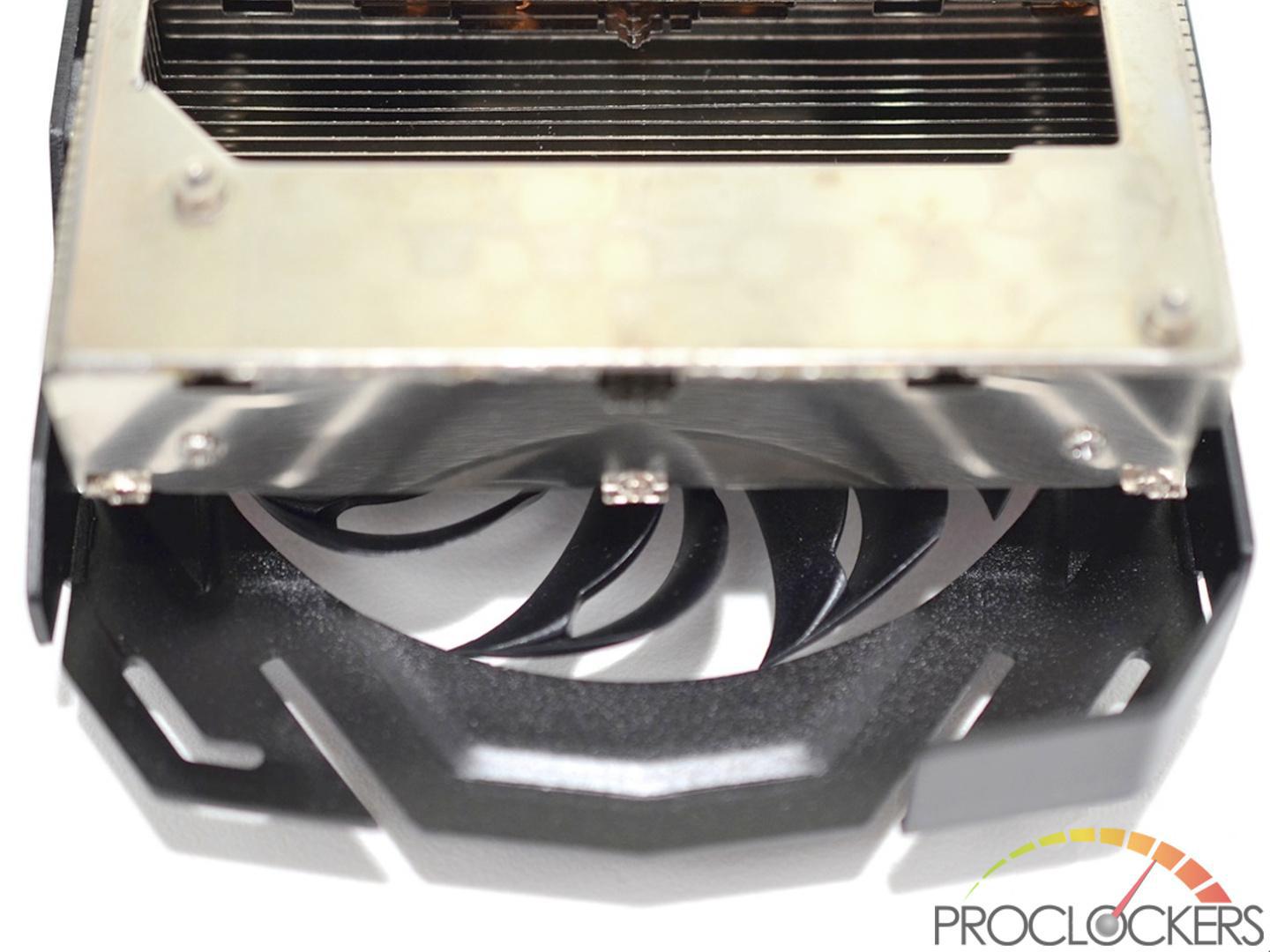
The cooler also overlaps the PCB.
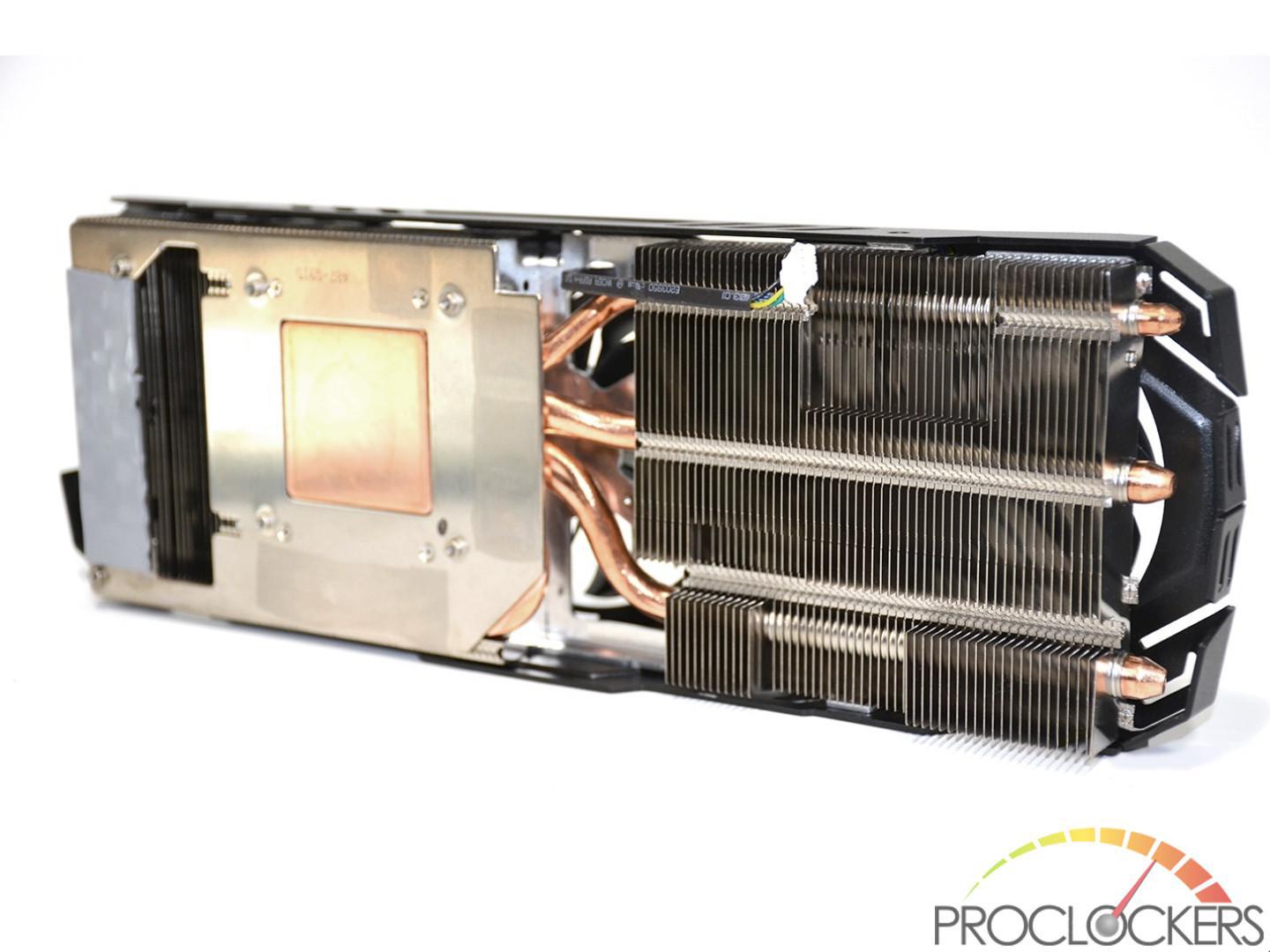
The Red Devil RX 570’s entire cooler.
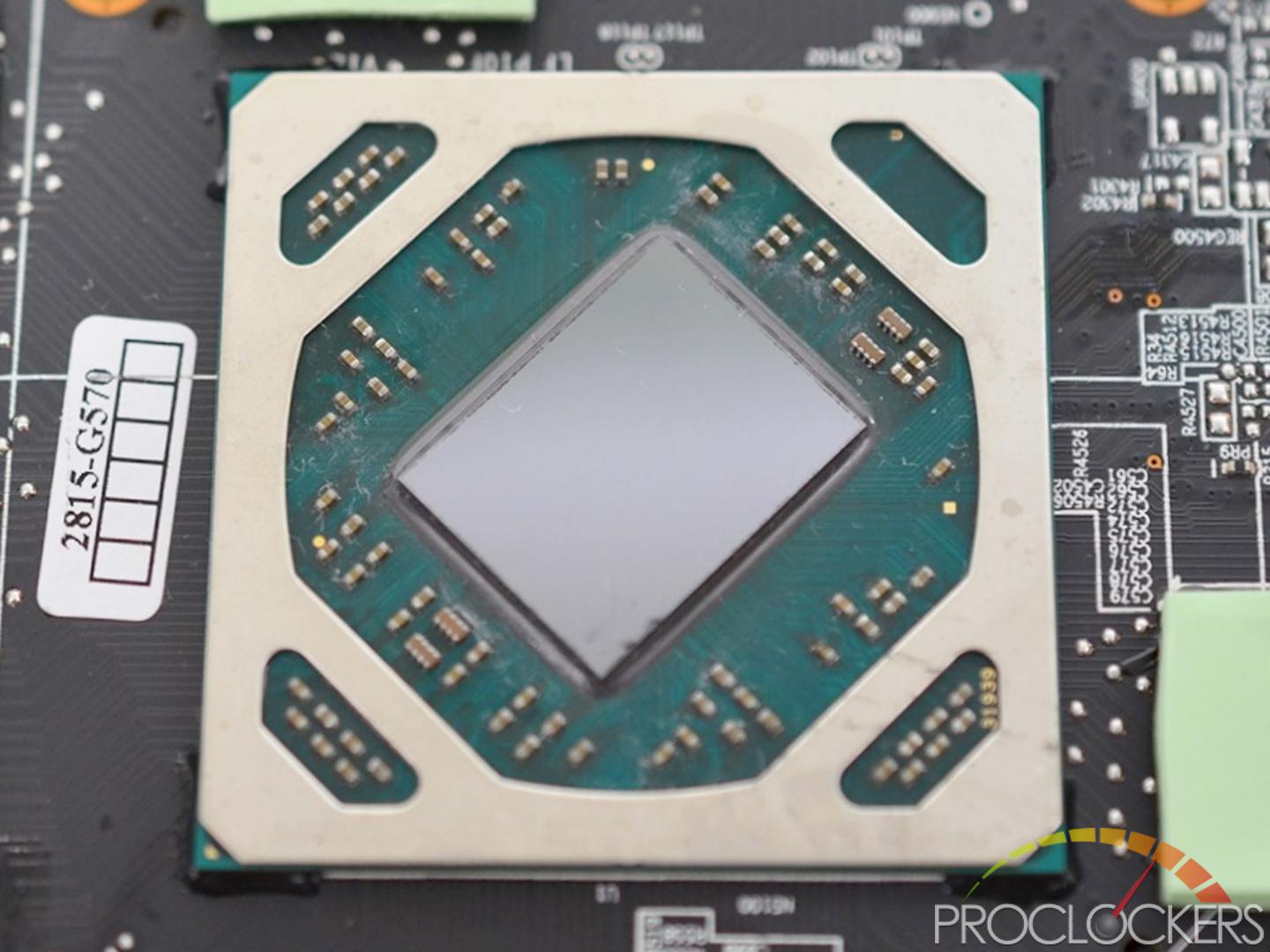
The core of the RX 570. the Polaris GPU die.

Around the GPU die, the 4 GB of GDDR5 memory is covered by thermal pads to help dissipate heat.
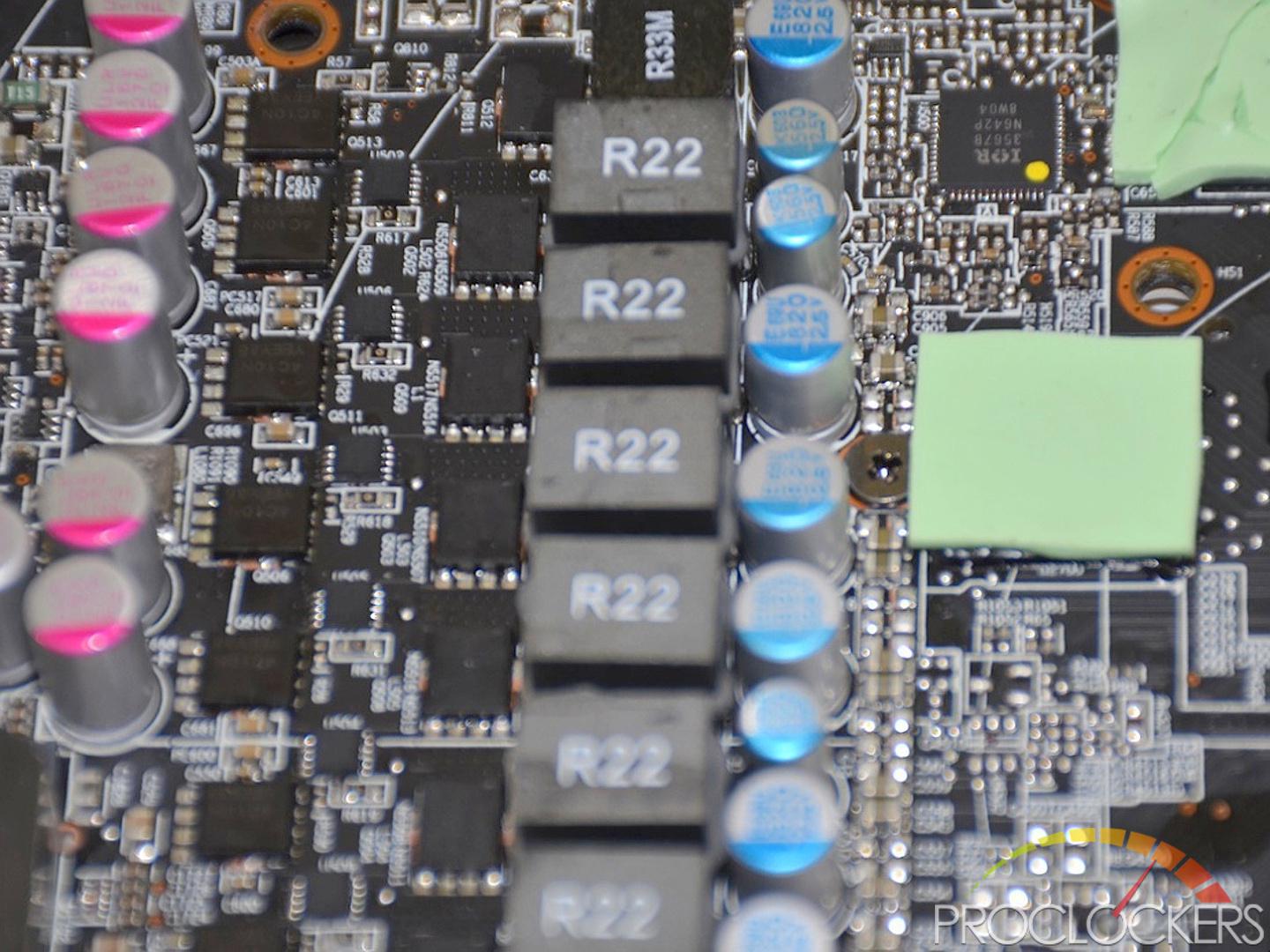
Powering the Red Devil RX 570 is PowerColor’s Gold Power Kit. This Gold Power Kit upgrades the digital PWM to control the voltage more precisely. It uses high-speed dynamic response in the digital signal to stabilize the voltage. The multiphase power delivery offers a sufficient power supply, better temperature control and delivers the highest ability for overclocking.
System Configuration
Test System
- Intel Core i7 7700k @ 5.0 GHz
- Aorus Z270X Gaming 5
- 32GB G.Skill Trident-Z DDR4 3200MHz
- Corsair HX850i 80+ Platinum PSU
- Swiftech H320‑X2 prestige AIO cooler
- 250GB Samsung 850 Evo M.2 SATA SSD
- Primochill Praxis Wetbench
Test Software
- Windows 10 Professional 64-Bit
- CPUID – CPU-Z
- TechPowerUp – GPU-Z
- AMDs Wattman Software
Synthetic Benchmarks
- Futuremark – 3DMark
- Maxon – Cinebench
- Unigine – Heaven
Game Benchmarks
- Battlefield 1
- Crysis 3
- Grand Theft Auto V
- Rise of the Tomb Raider
- Shadow of Mordor
- Thief
- Watch Dogs 2
- The Witcher 3
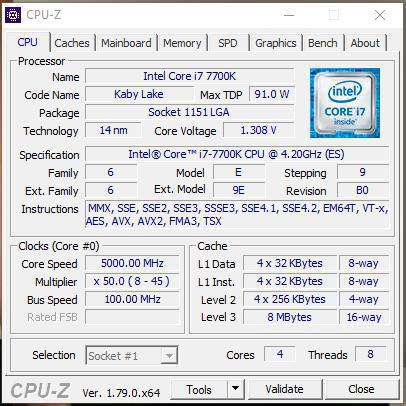
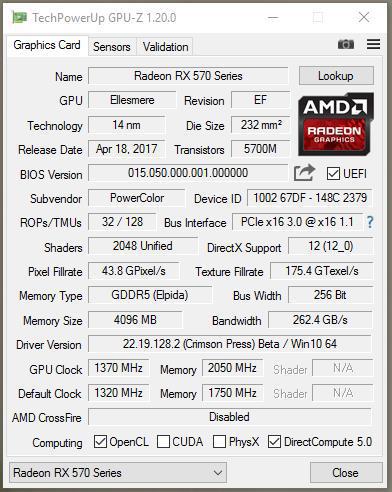
The ambient temperature was 20°c, or 68°f, during all testing. The GPU was kept at its stock clock during all testing, with one exception, 3DMark. The Red Devil RX 570 has a base clock of 1320MHz. I used AMDs new WattMan utility for overclocking the GPU. For the synthetic benchmarks, I tested OpenGL, DirectX 11, and DirectX 12. For the Gaming benchmarks, the games were run in 1920 x 1080p, 2560 x 1440p and 3440 x 1440p. I also usually run 4k benchmarks. However, my 4K monitor recently died and I have yet to replace it. I apologize for this and will resume 4K testing in my next review. Windows 10 Professional was used due to it being the most recent operating system. All games were run on high presets, with no MSAA or AA of any kind in any results. The advanced graphics settings in Grand Theft Auto V were left at their stock settings.
Synthetic Performance Testing
3DMark
3DMark is a computer benchmarking tool created and developed by Futuremark that is used to determine the performance of a computer’s 3D graphic rendering and CPU workload processing capabilities. It does this through a series of graphics and physics tests. I test both the Firestrike DX11 benchmark and the Time Spy DX12 Benchmark. Both benchmarks were run at stock clocks and at overclocked settings via AMD’s WattMan untilty.
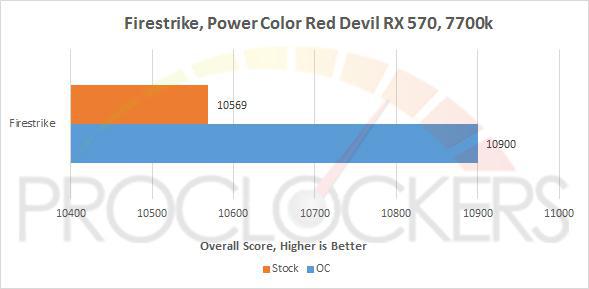
The Red Devil RX 570 achieved a high score of 10569 in Firestrike at stock clock and 10900 when overclocked.
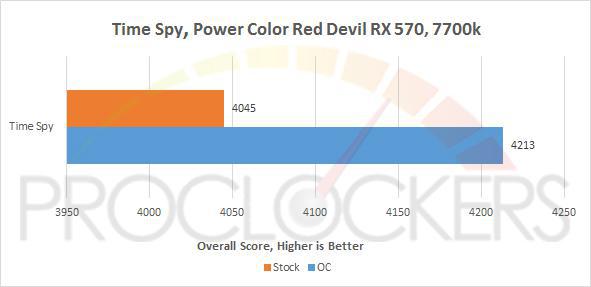
The Red Devil RX 570 achieved a high score of 4045 in Time Spy at stock clock and 4213 when overclocked.
Cinebench
Cinebench is a synthetic benchmark evaluates your computer’s performance capabilities. It’s based on MAXON’s animation software Cinema 4D, which is used by studios and production houses worldwide for 3D content creation.

The Red Devil RX 570 scored as respectable 118.03 fps in the OpenGL test.
Unigine Heaven
The Heaven Benchmark is a DirectX 11 benchmark designed to stress your GPU under heavy loads. The Heaven Benchmark can be used to determine the stability of a GPU under extremely stressful conditions.
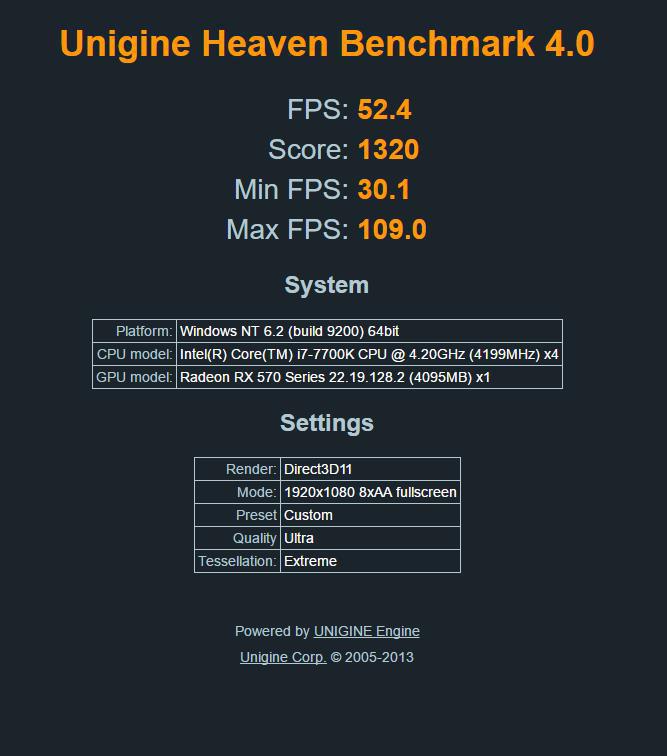
I ran the heaven benchmark with the Ultra Quality preset with Extreme Tessellation, 8xAA, in 1080p using the DX 11 API. With these settings, the Red Devil RX 570 received an overall score of 1320 with an average FPS of 52.4, a minimum of 30.1 and a maximum of 109.
Gaming Performance Testing
There were 8 games tested, a mix of newer titles and a few older ones, but none older then 2013.They were tested in 1080p, 1440p and 3440 x 1440. All games were played at their high presets, with no AA of any kind. A quick side note, on GTA V I didn’t adjust the advanced graphics settings at all. They were left at their stock settings. Each benchmark run was timed at 120 seconds, ran three times each, then averaged out to get the final results. The games are as listed.
- Battlefield One
- Crysis 3
- Grand Theft Auto 5
- Rise of the Tomb Raider
- Shadow of Mordor
- Thief
- Watch Dogs 2
- The Witcher 3
It was no real surprise that the Red Devil RX 570 did best in 1080p. However, it did fairly well in both 2560 x 1440 and 3440 x 1440 as well. All games averaged over 30 FPS in all 3 resolutions, many games even staying over 60 FPS in all tests. Only 2 games failed to average 60 frames per second or higher in 1080p, Witcher 3 and Watch Dogs 2. Both are very demanding games in this really didn’t surprise me too much. They were also, along with Crysis 3, the only games to average below 60 FPS in 1440p. Lastly, all games stayed above 30 FPS in 3440 x 1440 Ultra wide. Both GTA V and Shadow of Mordor even stayed above 60 FPS in this resolution.
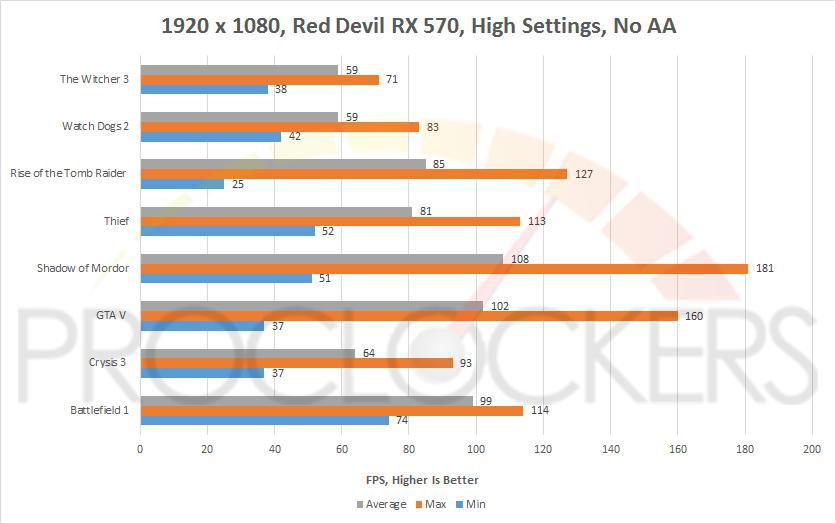
Even though all games did great in 1080p, Shadow of Mordor was the best with an average of 108 FPS.
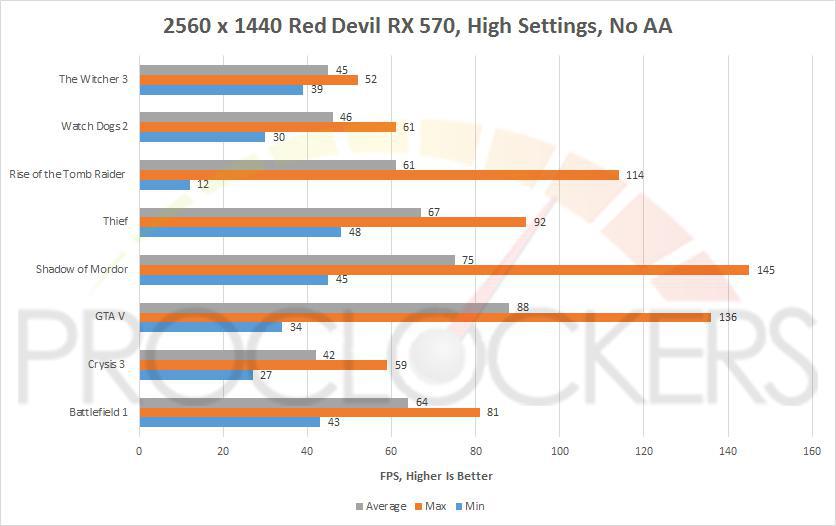
In 1440p, GTA V did best, averaging 88 FPS on high settings.
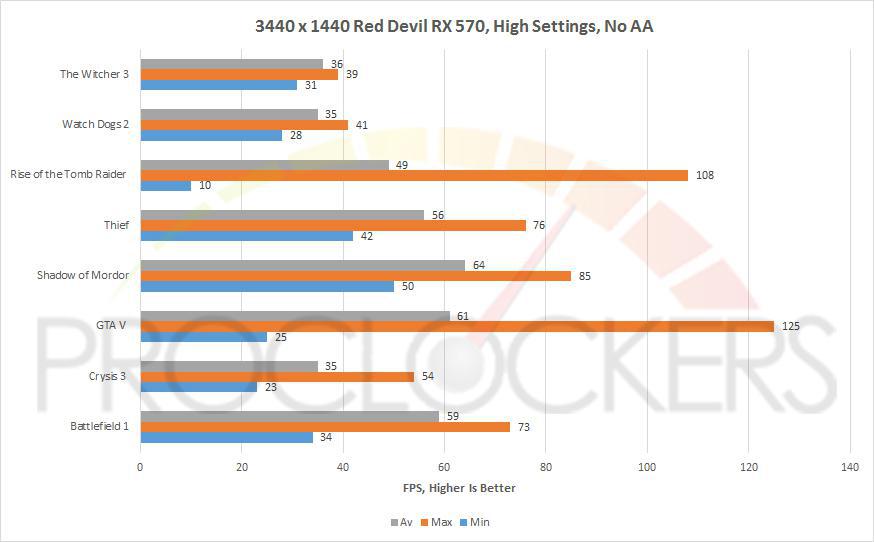
Once again, Shadow of Mordor did best, this time in 3440 x 1440p averaging 64 FPS.
Overclocking and Temperatures
For overclocking, I used AMD’s WattMan utility. WattMan is AMD’s overclocking utility that controls GPU voltage, engine clocks, memory clocks, fan speed and temperature. It’s packaged with the Radeon software features and offers multiple ways of precise overclocking controls. With the control over voltage and per state frequency curve for GPU clocks, comprehensive tuning control is now available. It’s very easy to learn and use, especially when compared to other utilities out there.
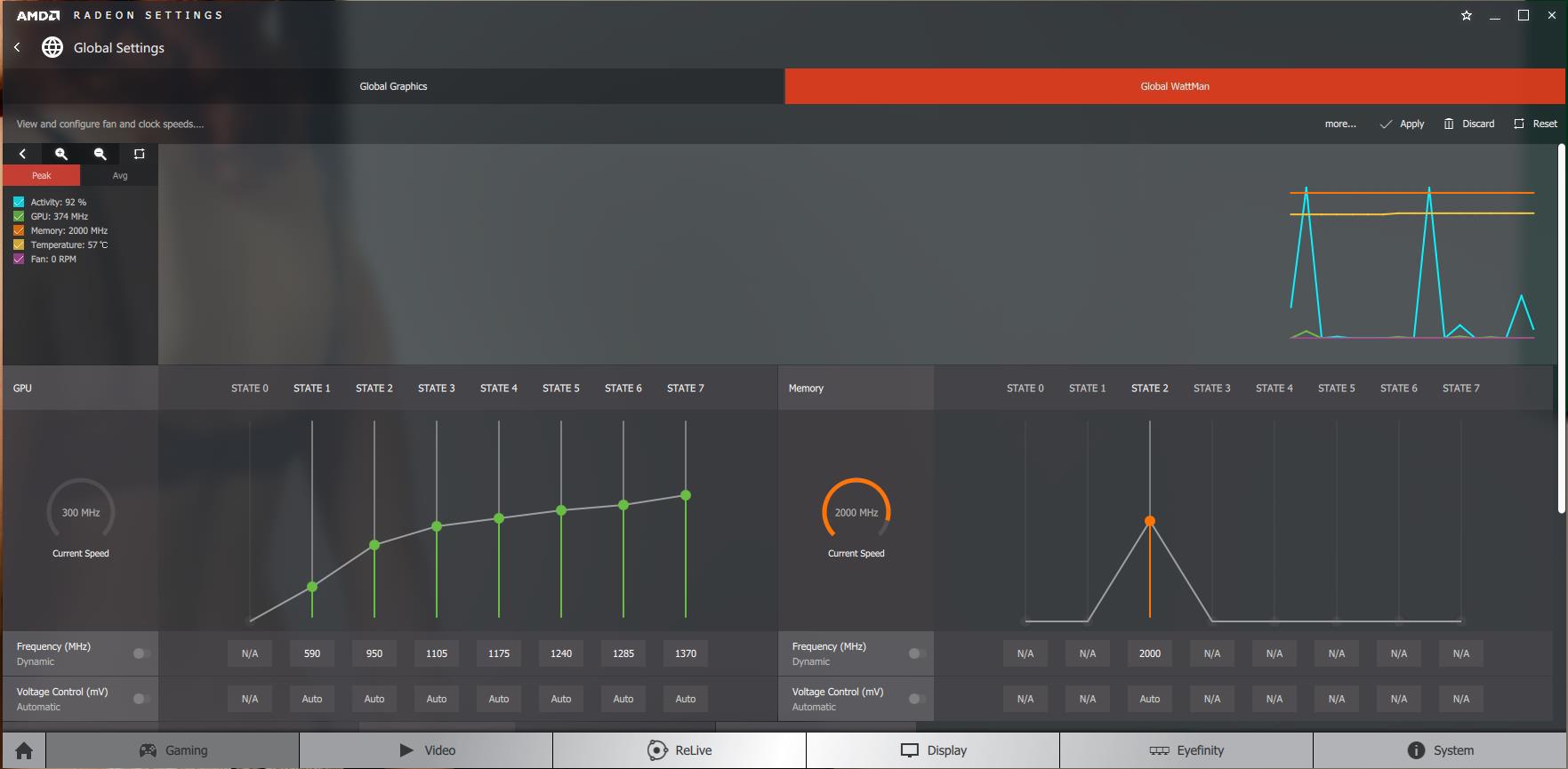
After bit of fine tuning, I ended up with +50MHz (1370Mhz) Boost on the core and +1000MHz (8000MHz) on the memory. This was an increase of 4% for the core and 14% on the memory.

Maximum temperature of the Red Devil RX 570 was 78°c, just below the G1 Gaming RX 480.
Final Thoughts and Conclusion
I hadn’t expected the RX 570 to be that far off from the RX 470, however I was pleasantly surprised. In both Firestrike and Time Spy, the Red Devil RX 570 beat out its RX 470 counterpart by a fair amount. In Time Spy, on Stock settings, there was about a 500-point difference between the RX 470 and RX 570, with the RX 570 coming out on top. Firestrike results were much in the same. However, the overclocked results showed even more of an improvement between the two cards of almost 600 points. Gaming was more of the same with the RX 570 pulling a head of the RX 470, even if only by a few FPS. The same goes for overclocking, the RX 570 clocked slightly higher than the RX 470, even if only by 5MHz.
Overall, I was very impressed with the increased performance of the Red Devil RX 570 over the RX 470. It’s not just the performance that has improved. With the Red Devil RX 570 having three fans, as compared to the two fans on the RX 470, its gives the card more of a high-end feel. This card is great for anyone who just wants to play on higher settings, in 1080p. Also, great card for a budget build. The PowerColor RED DEVIL Radeon RX 570 is currently priced at $189.99 in Newegg.
Pros
- Good Price
- Great 1080p Performance
- High-End Cosmetics
Cons
- None







